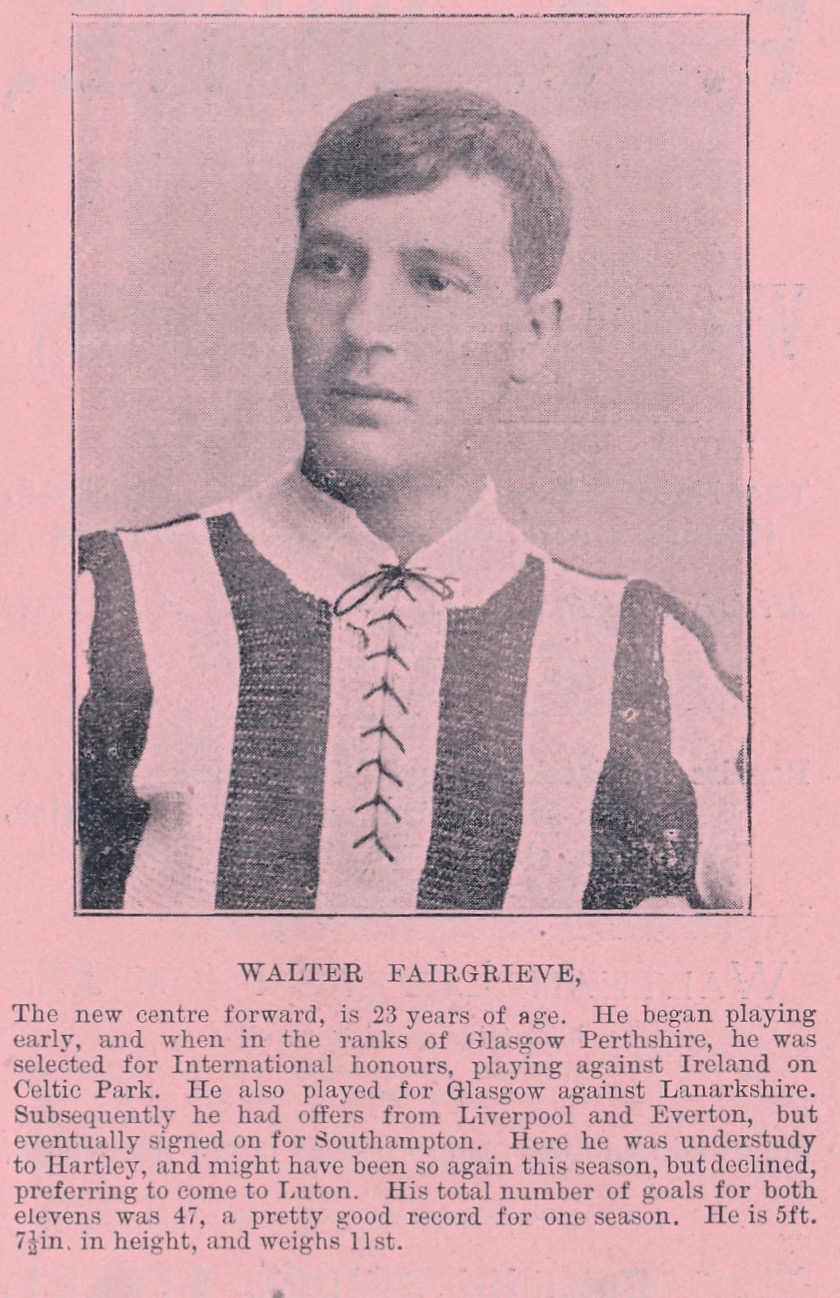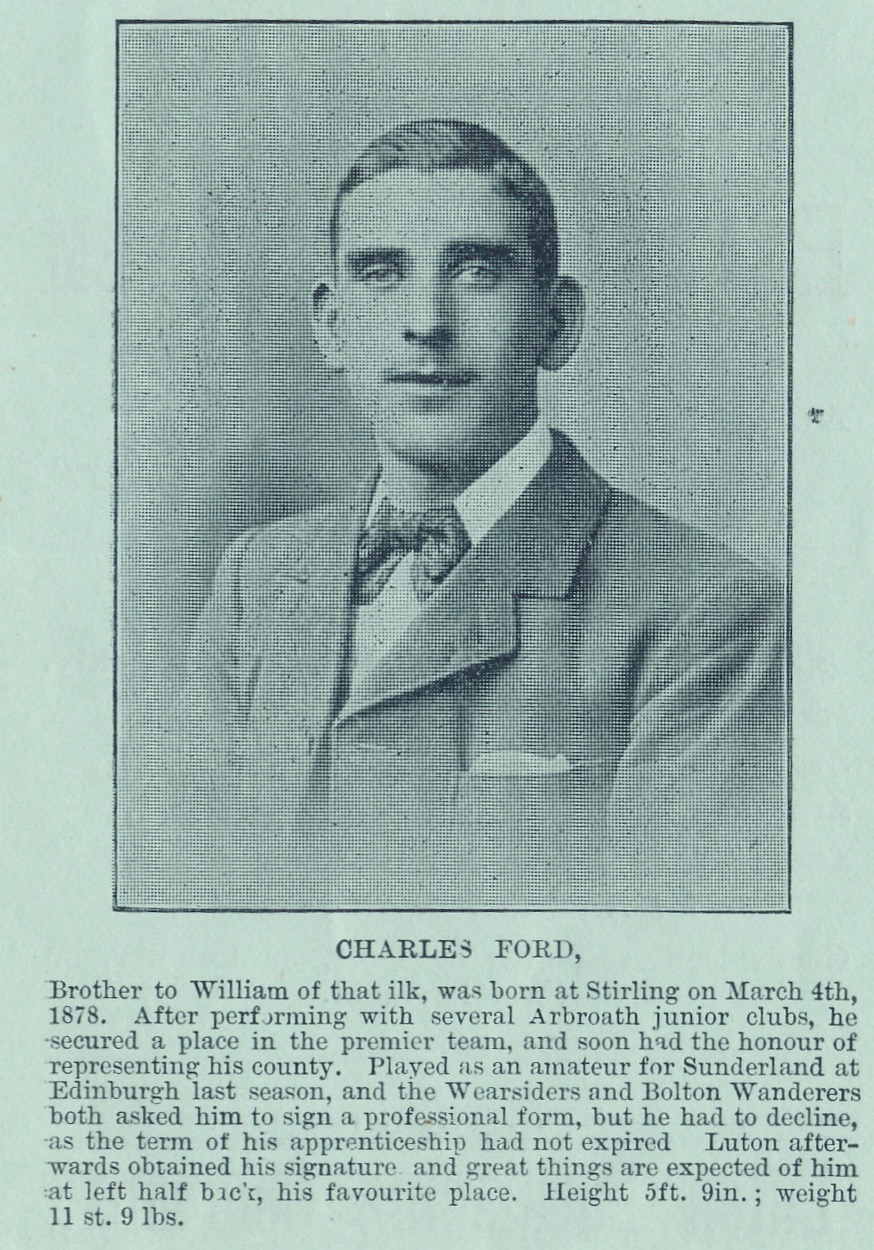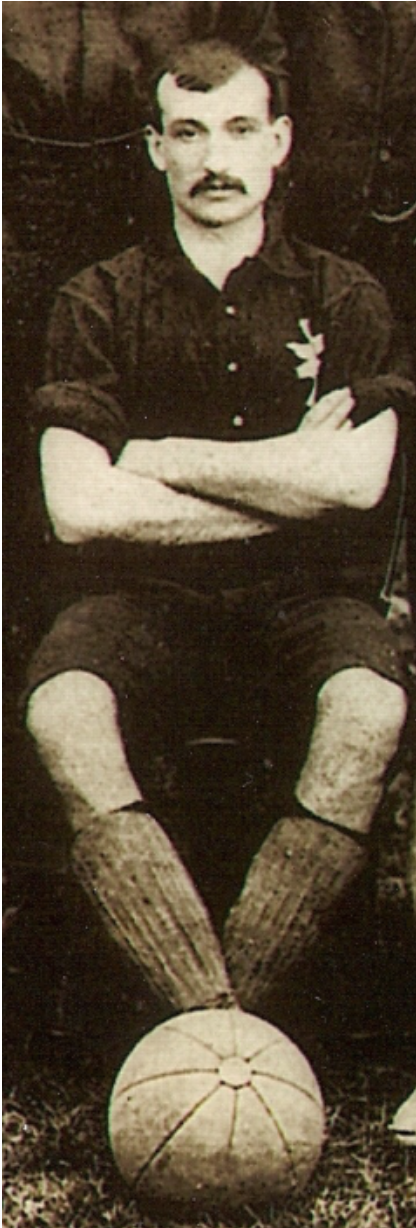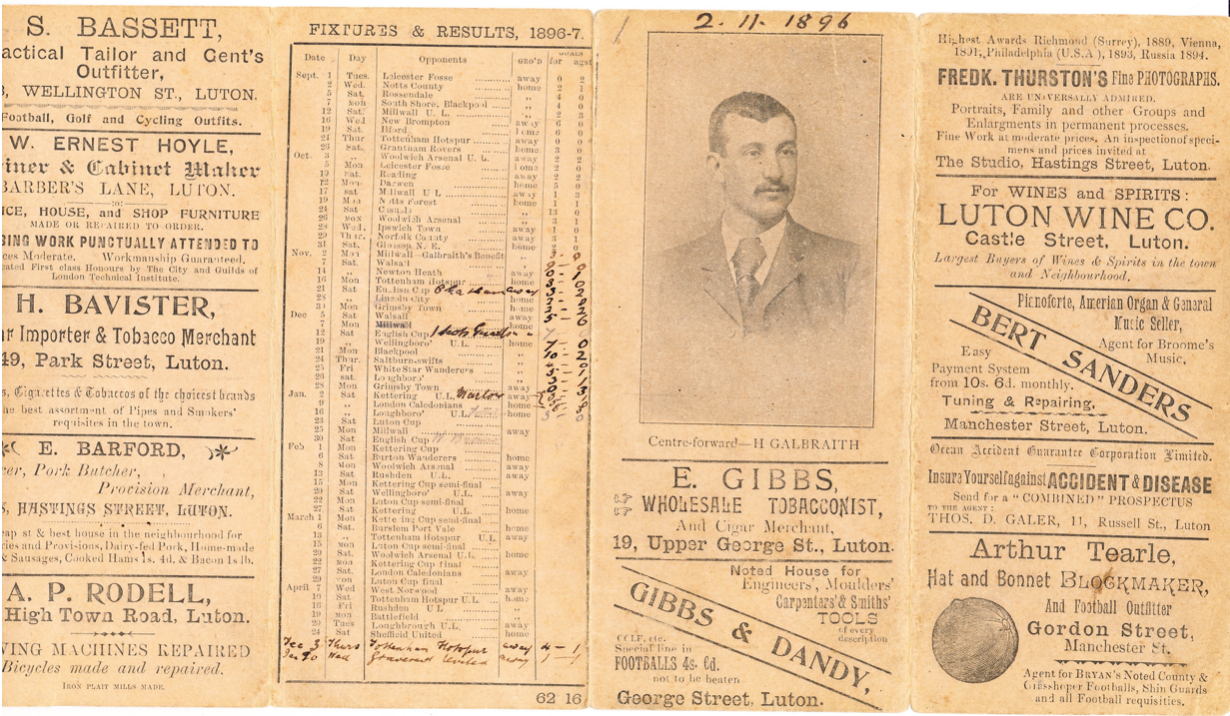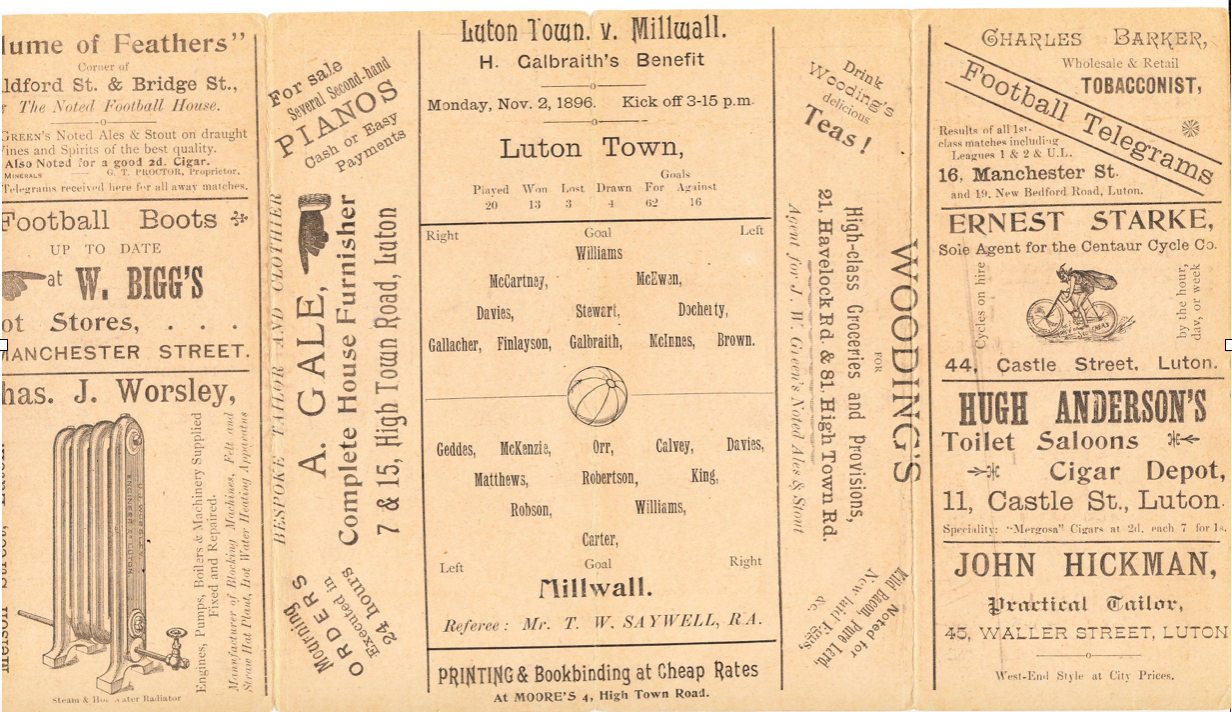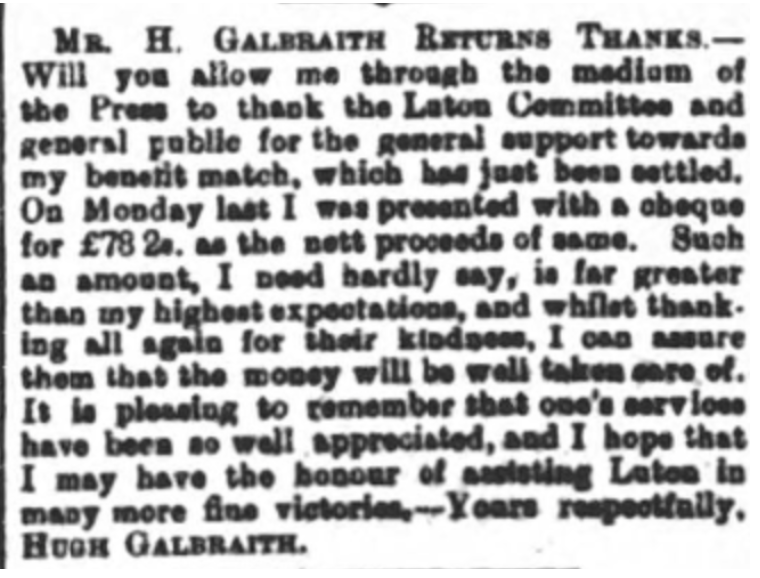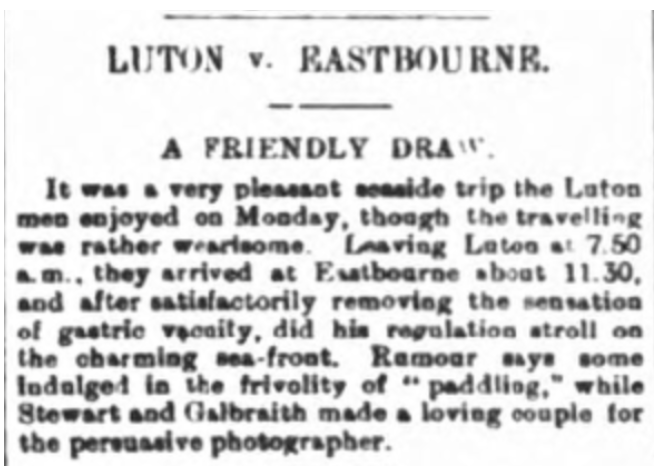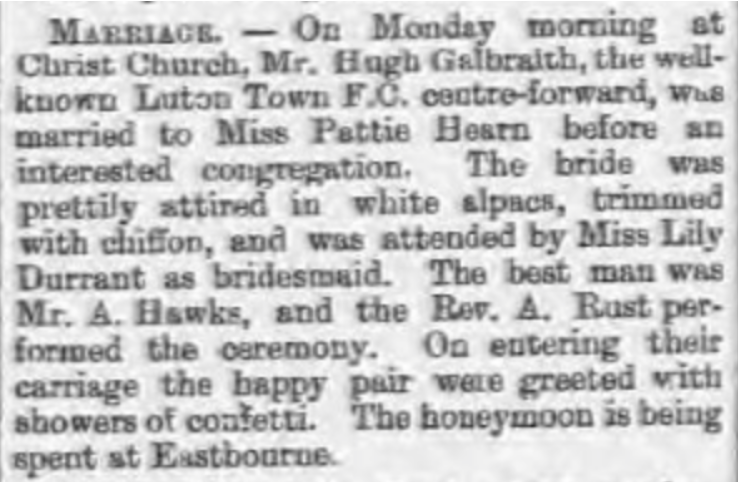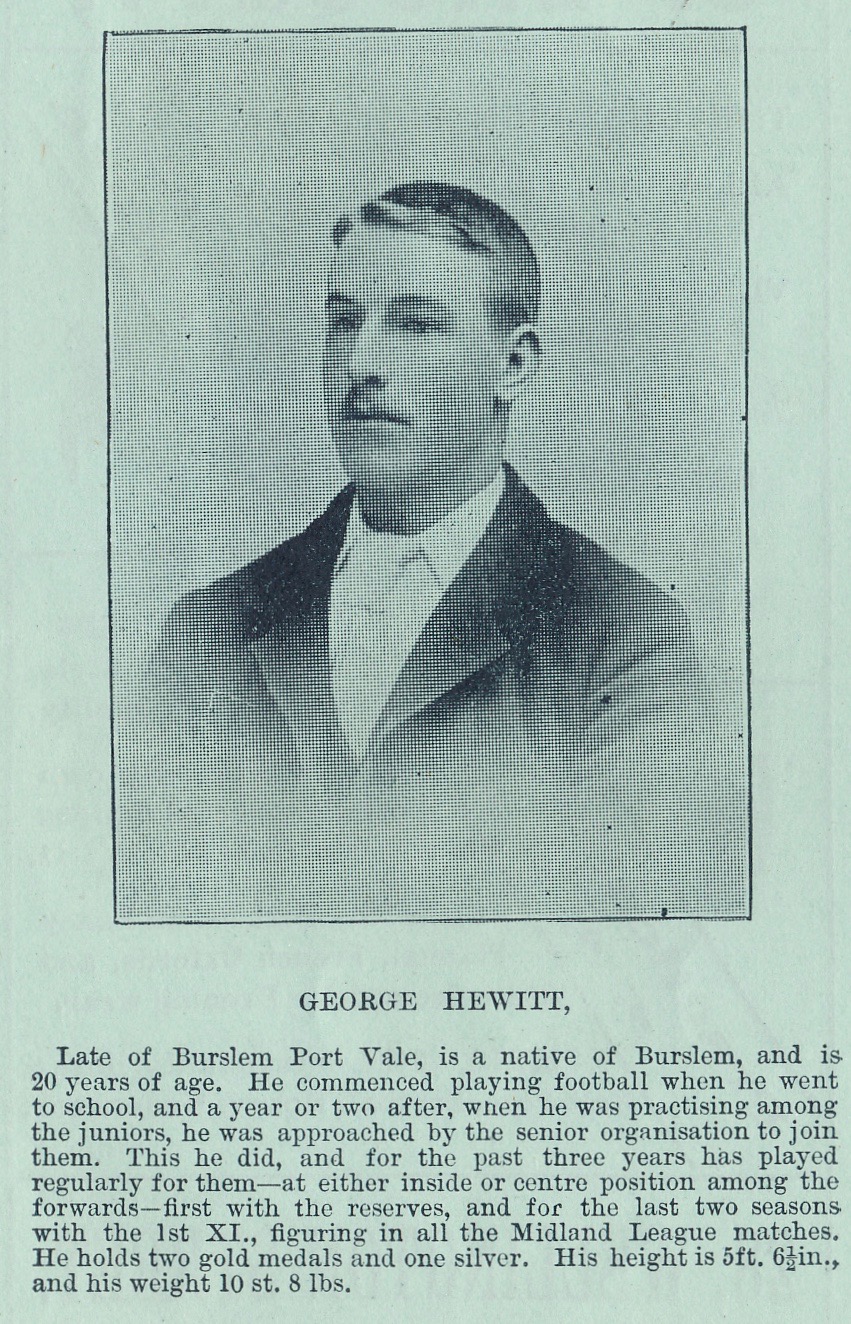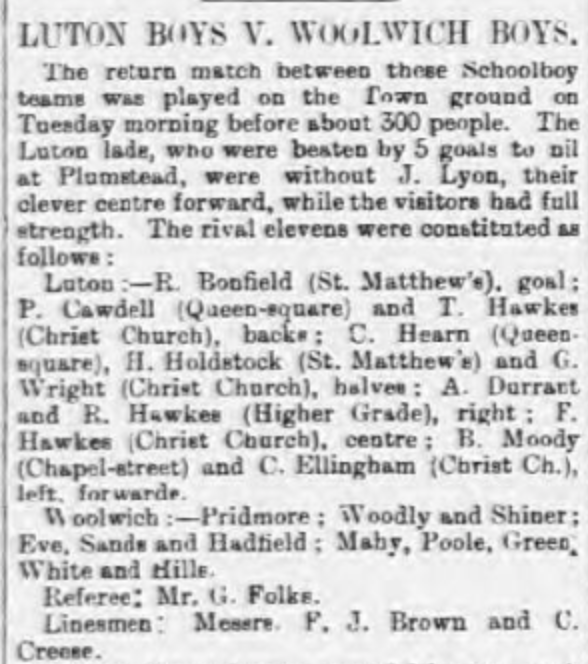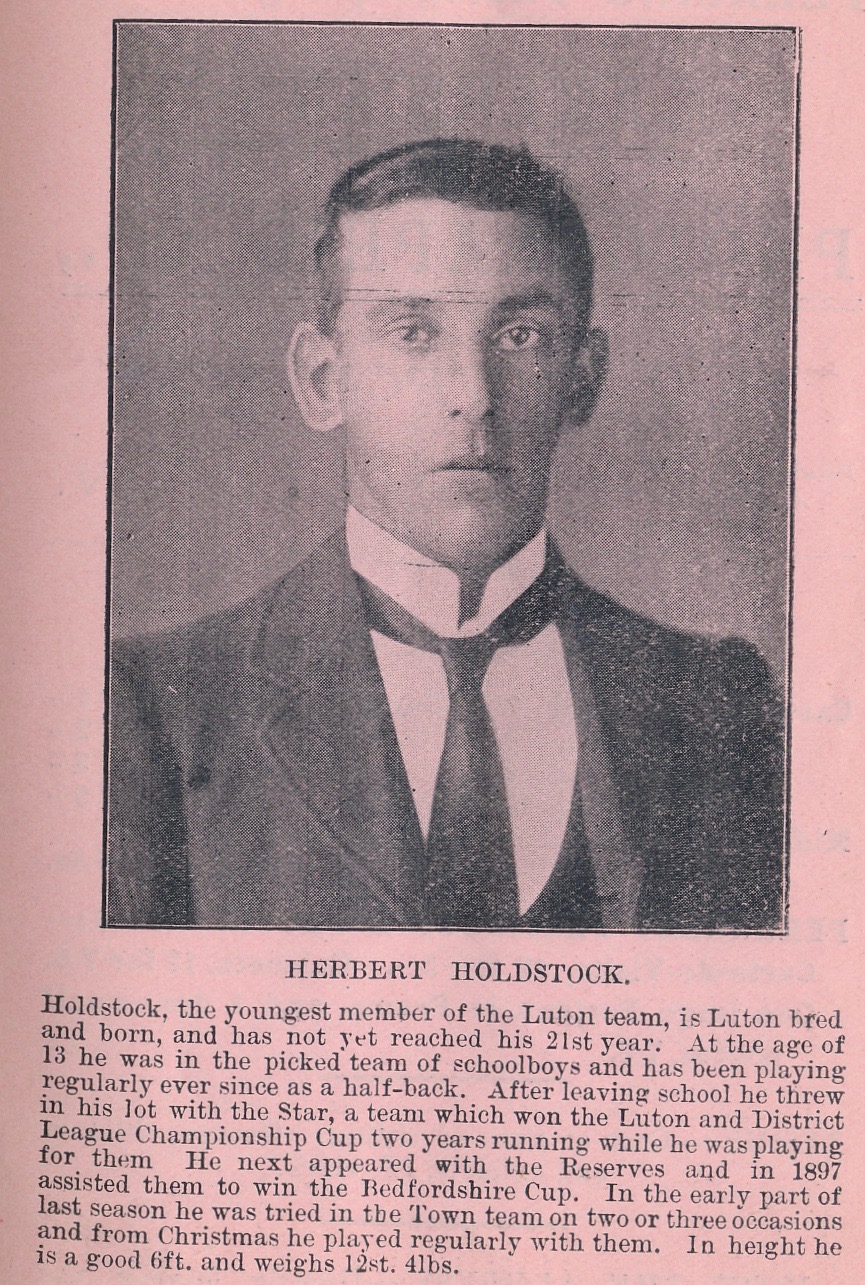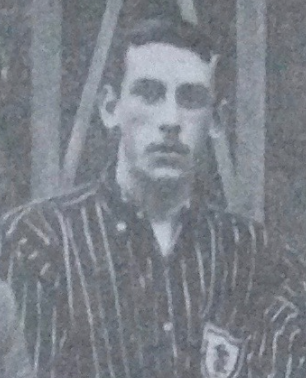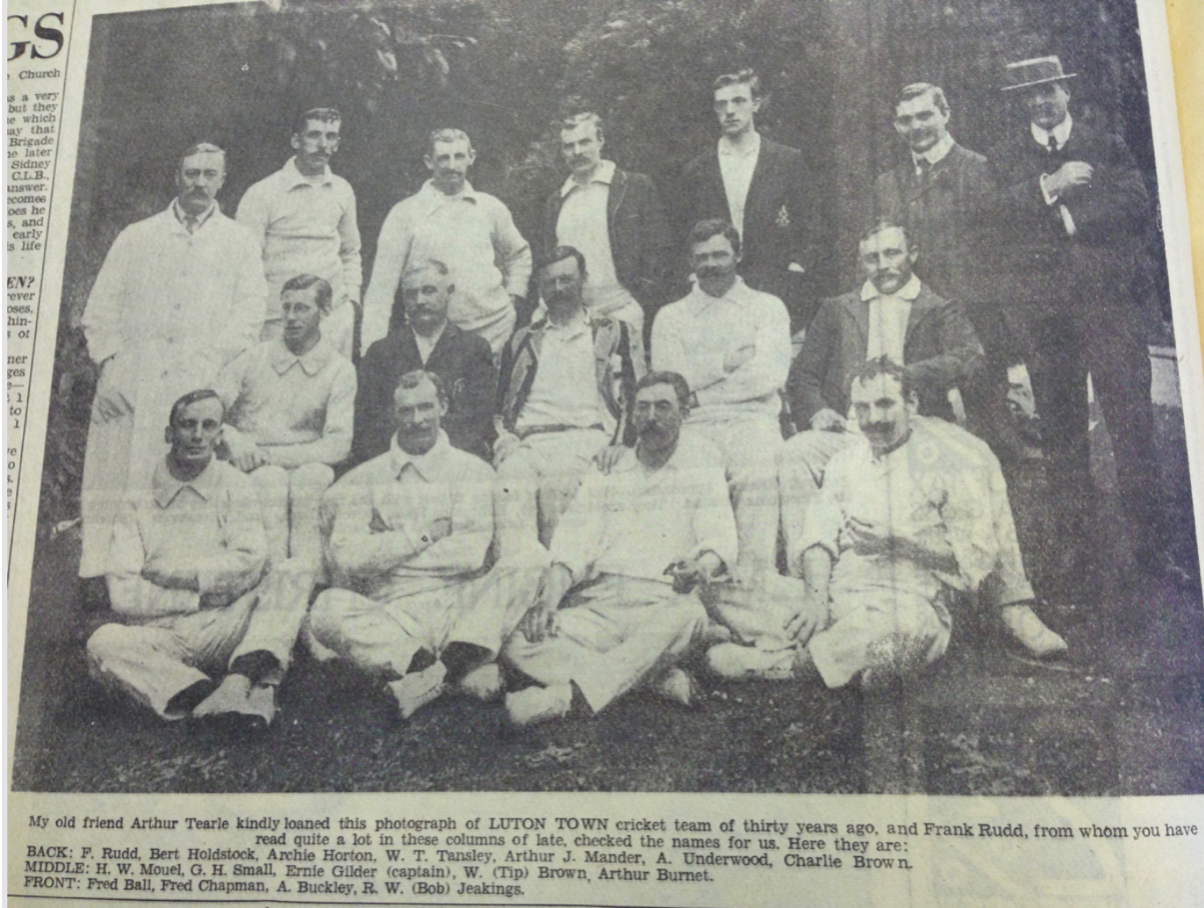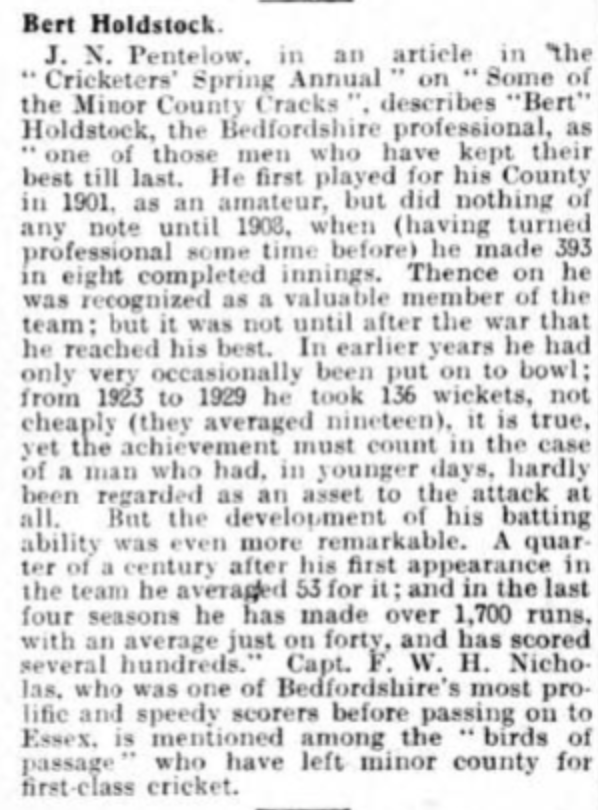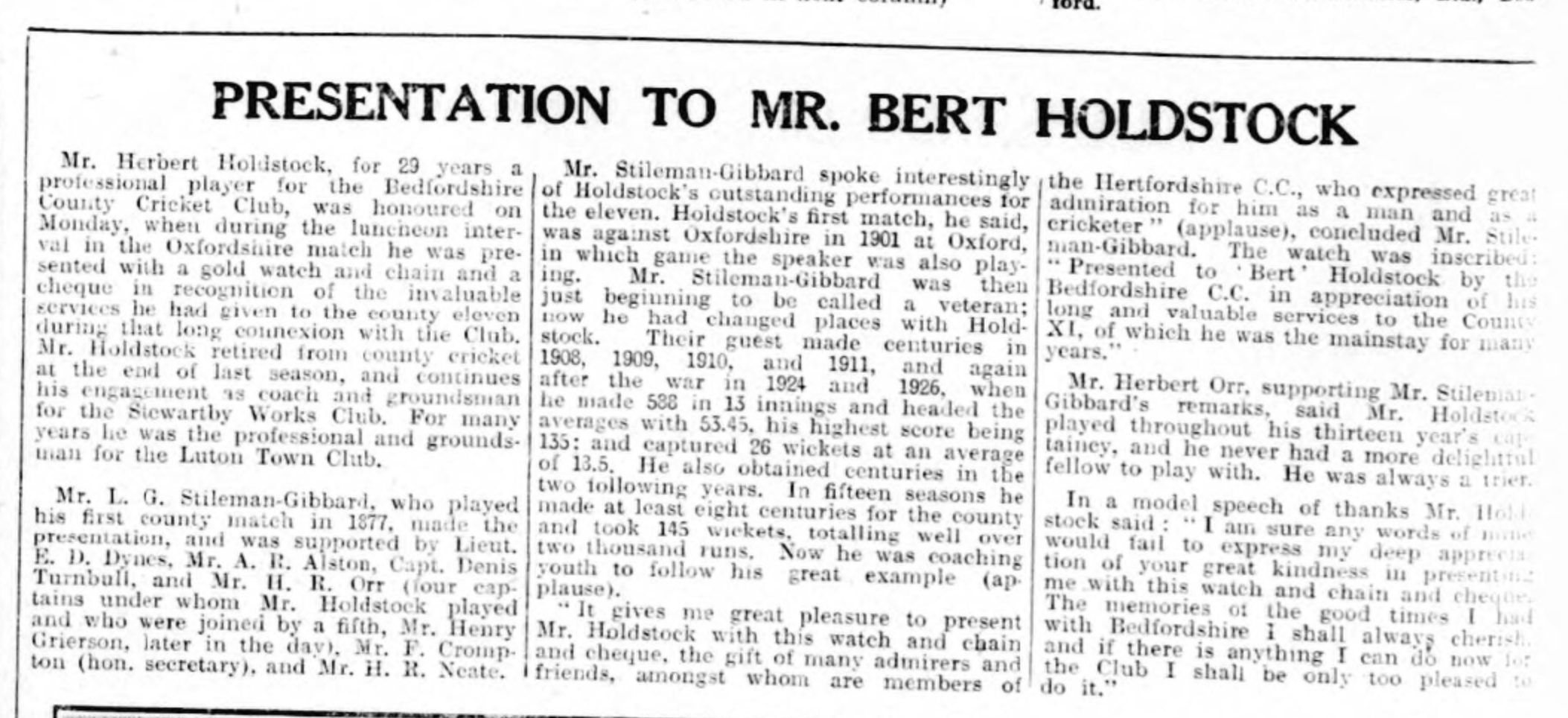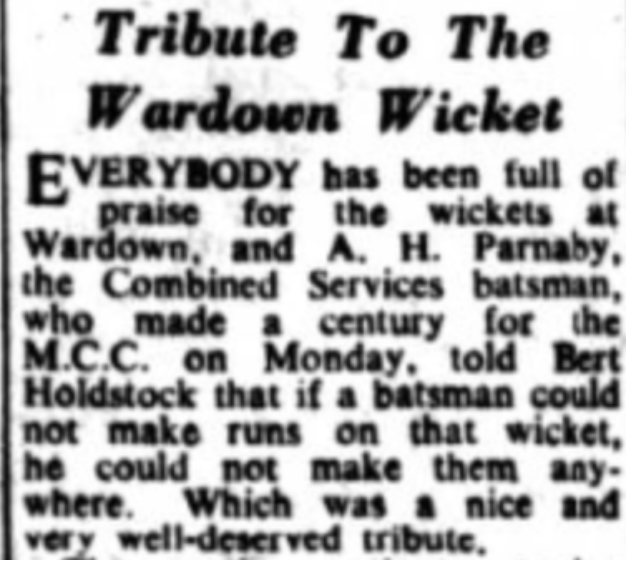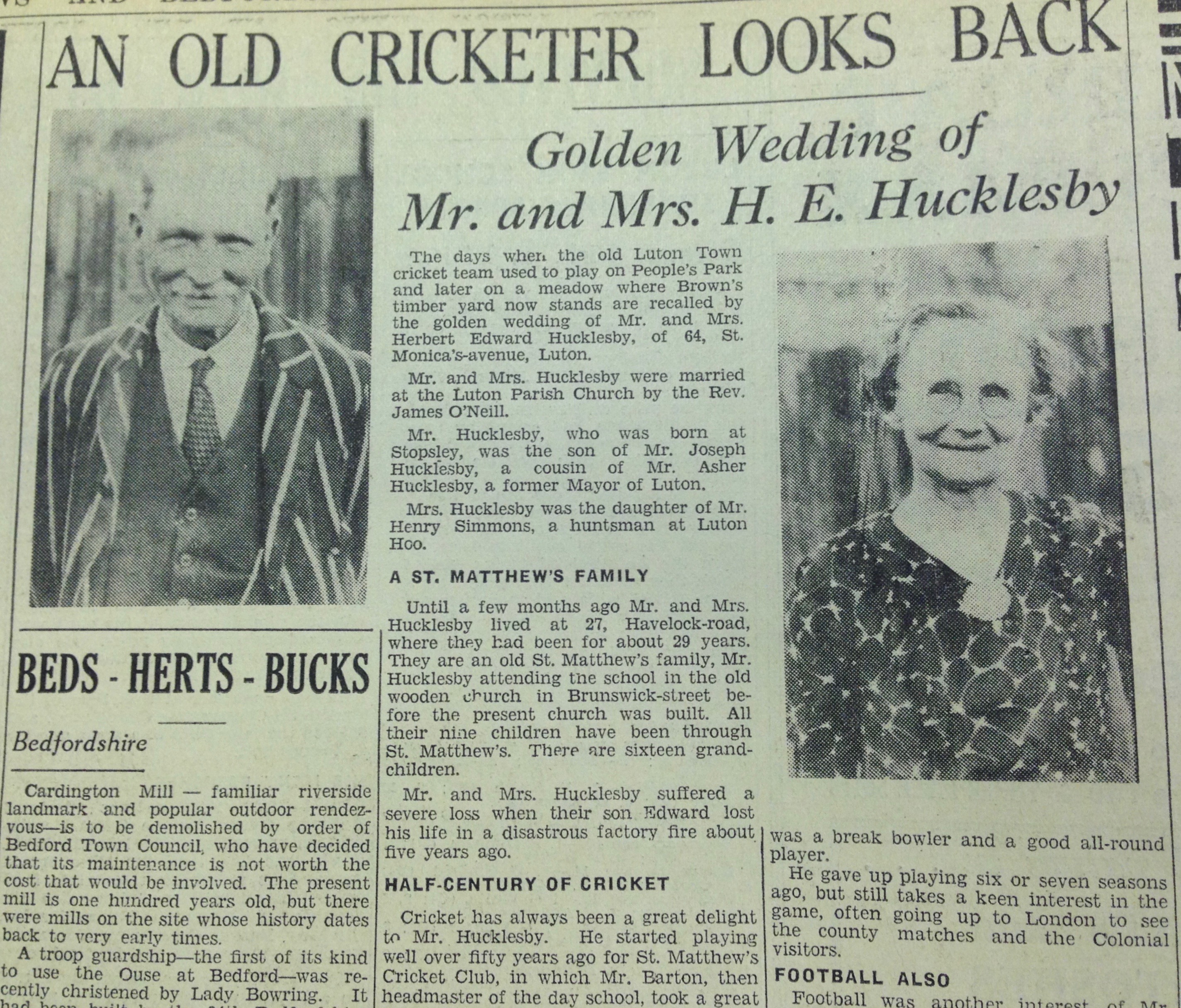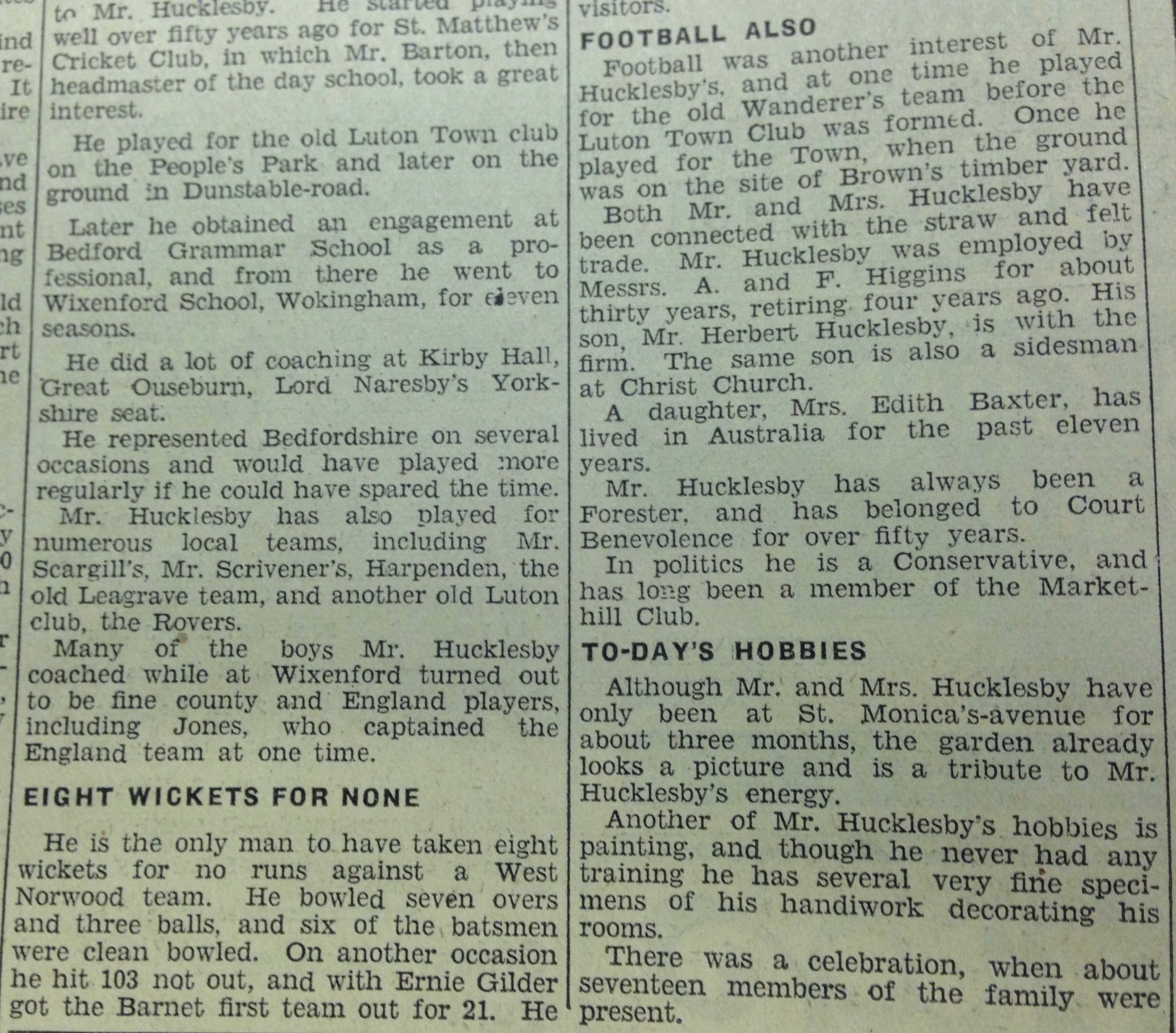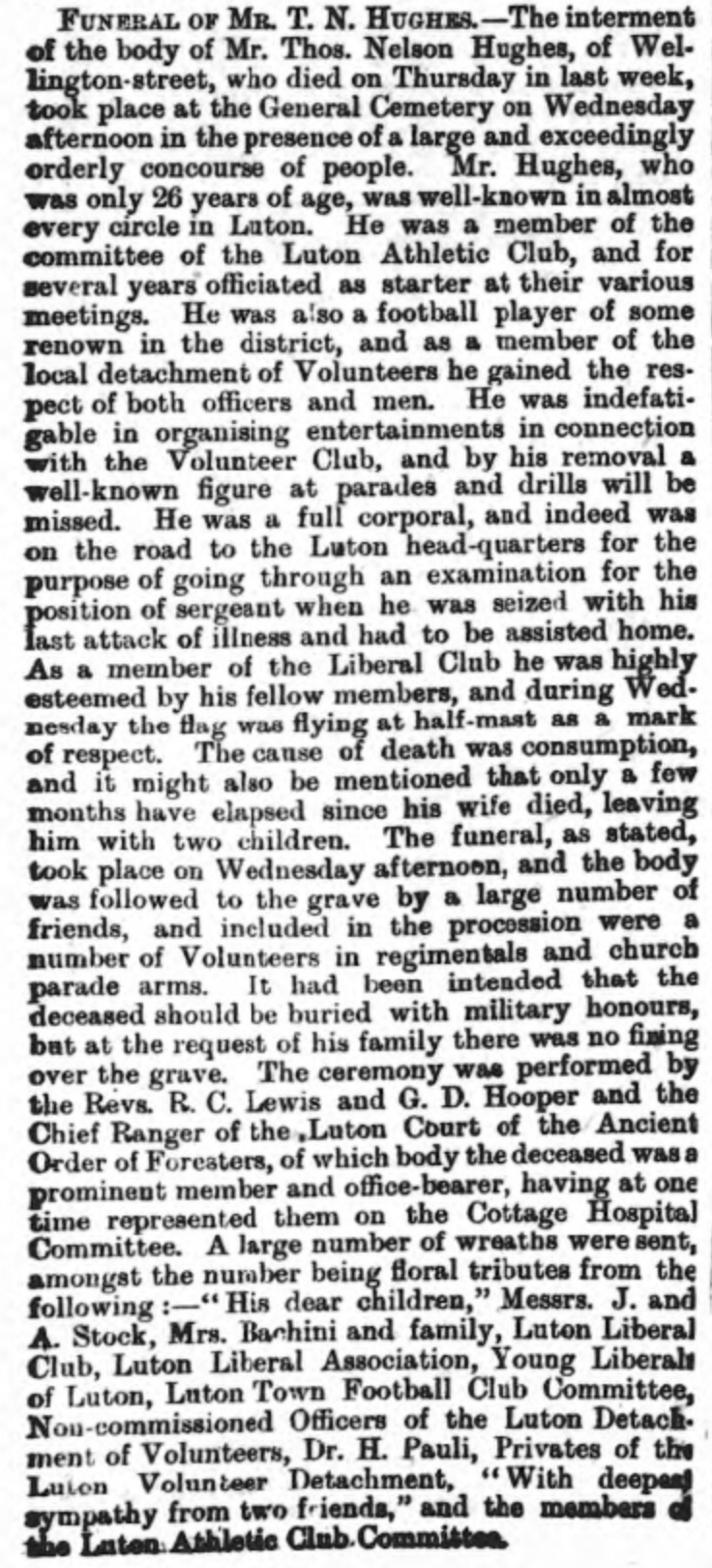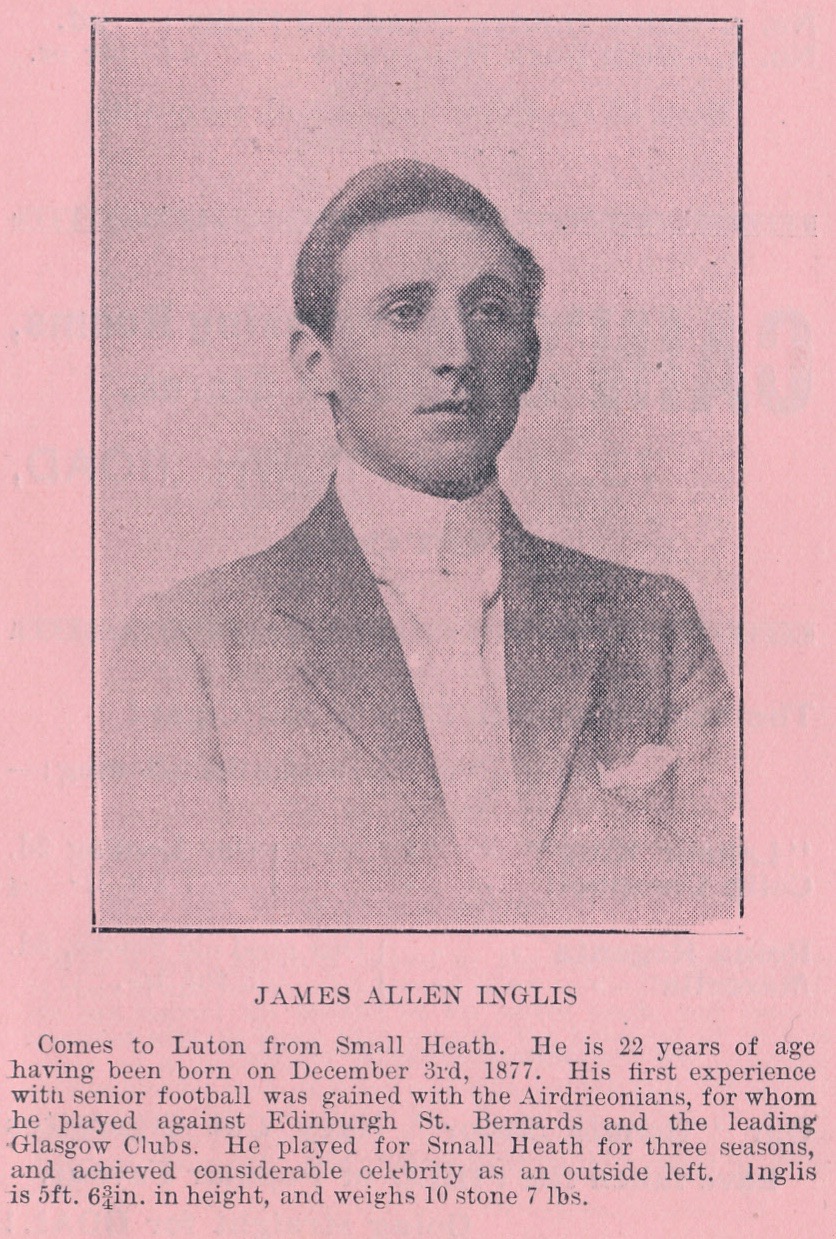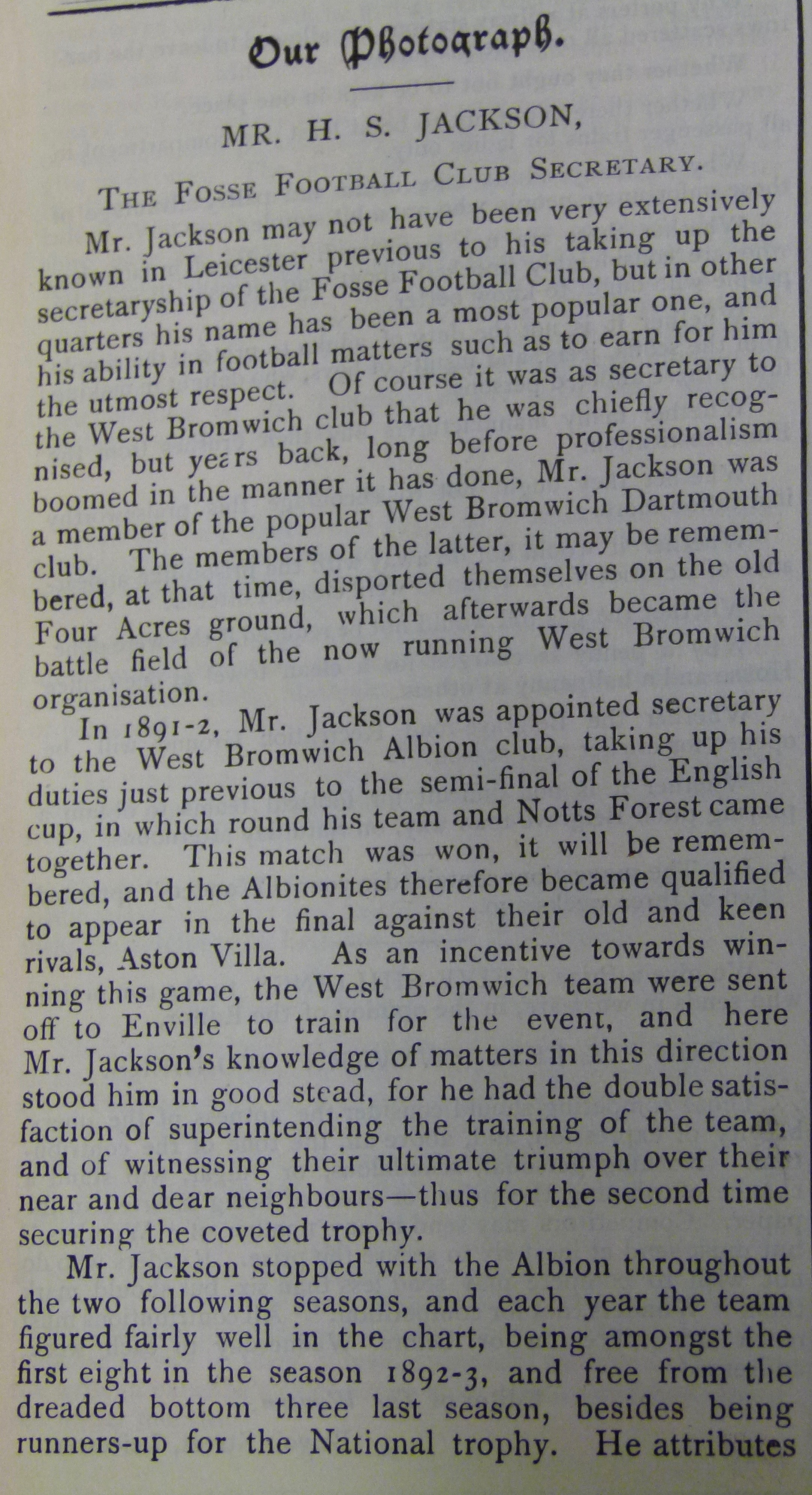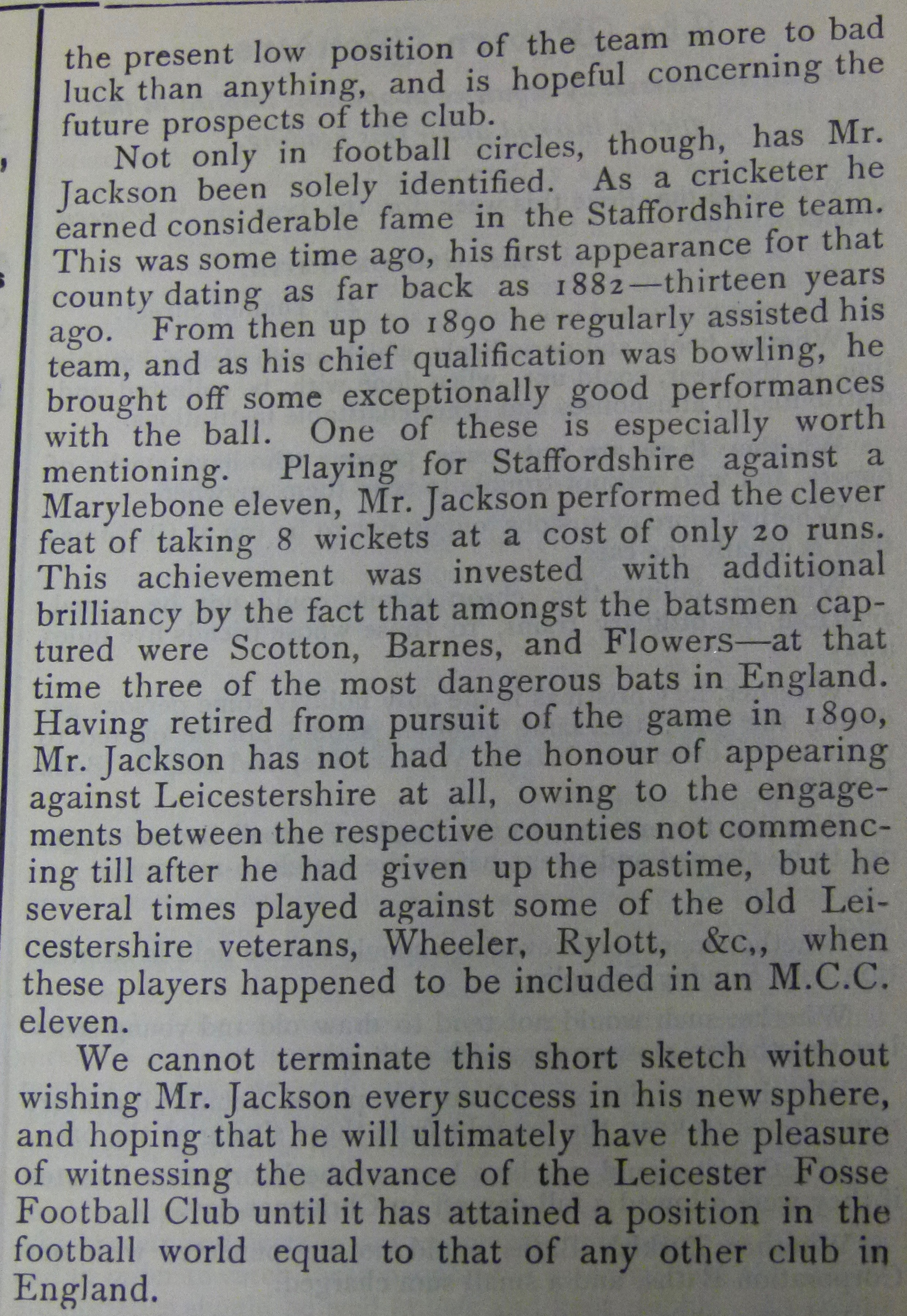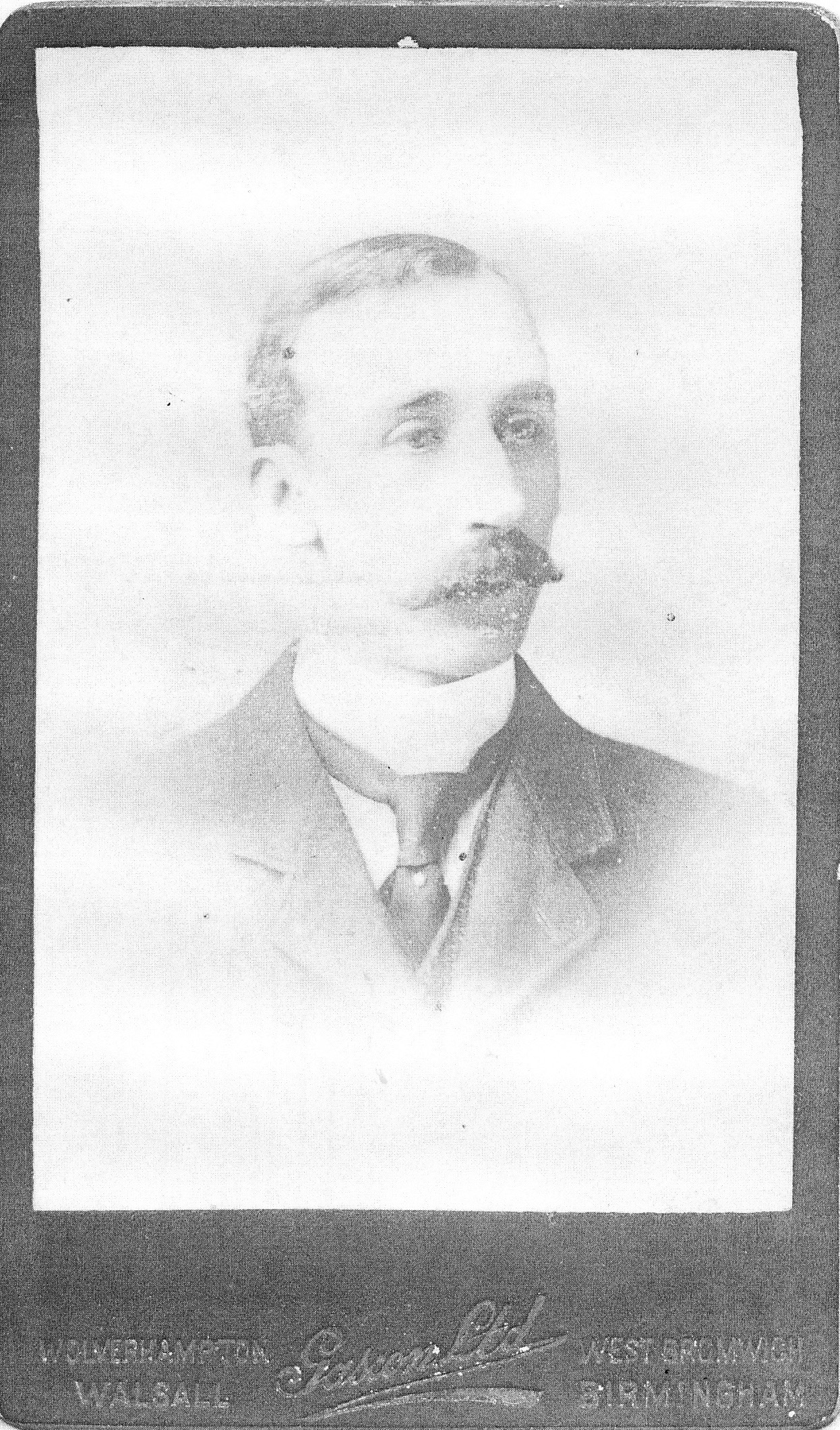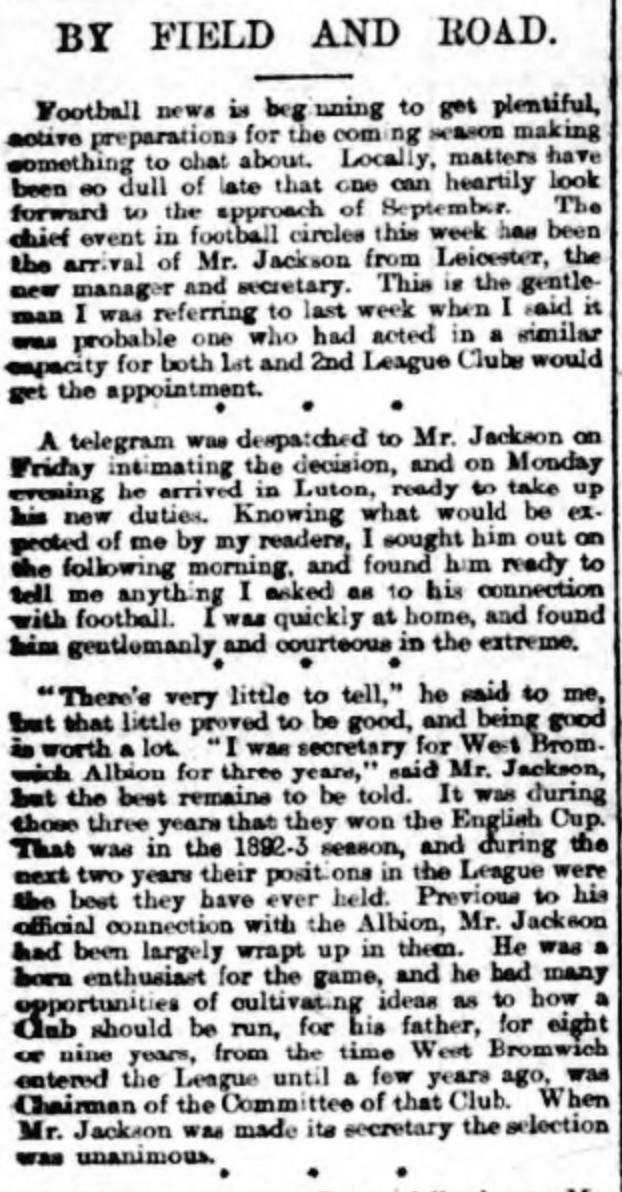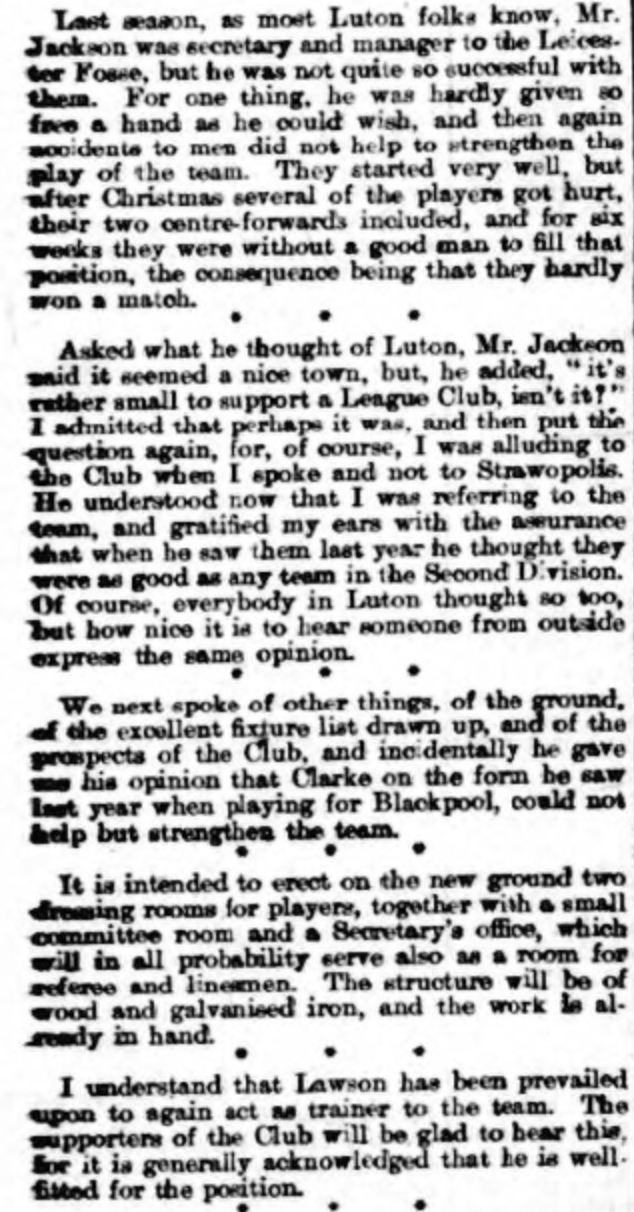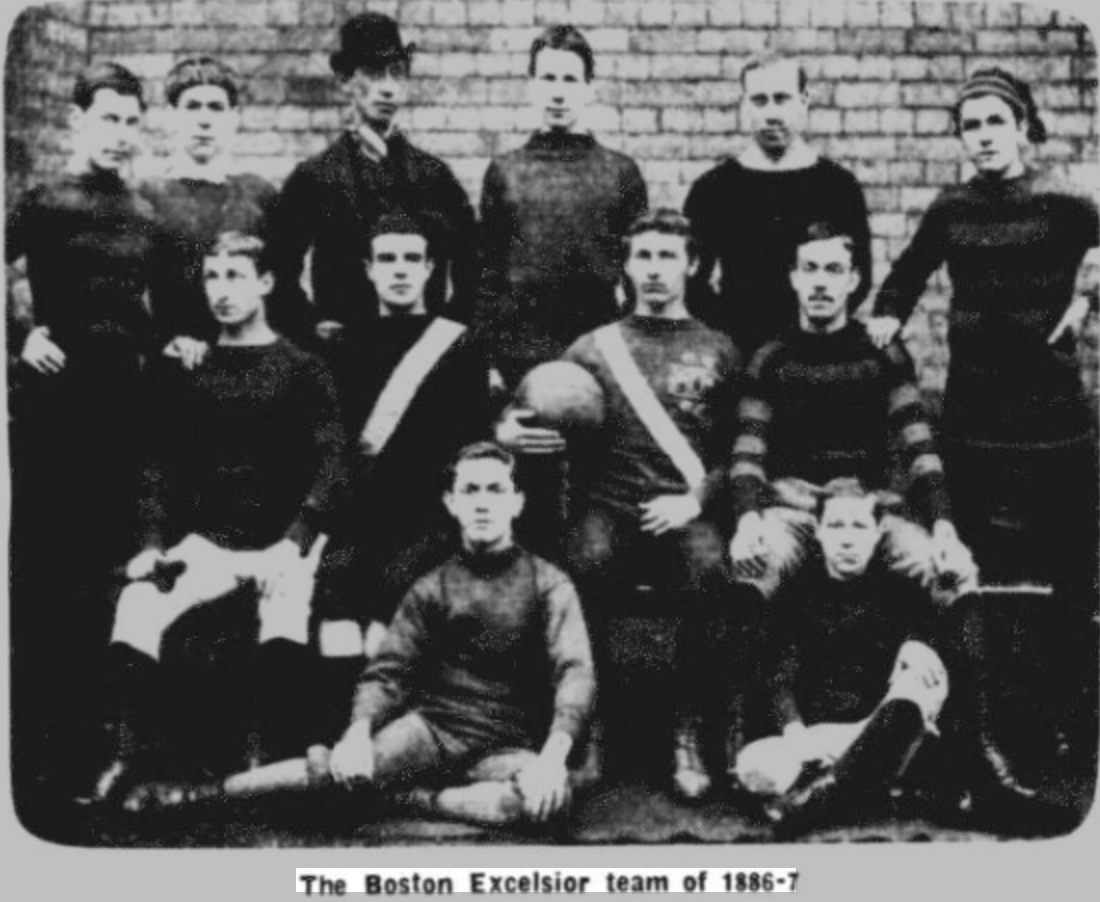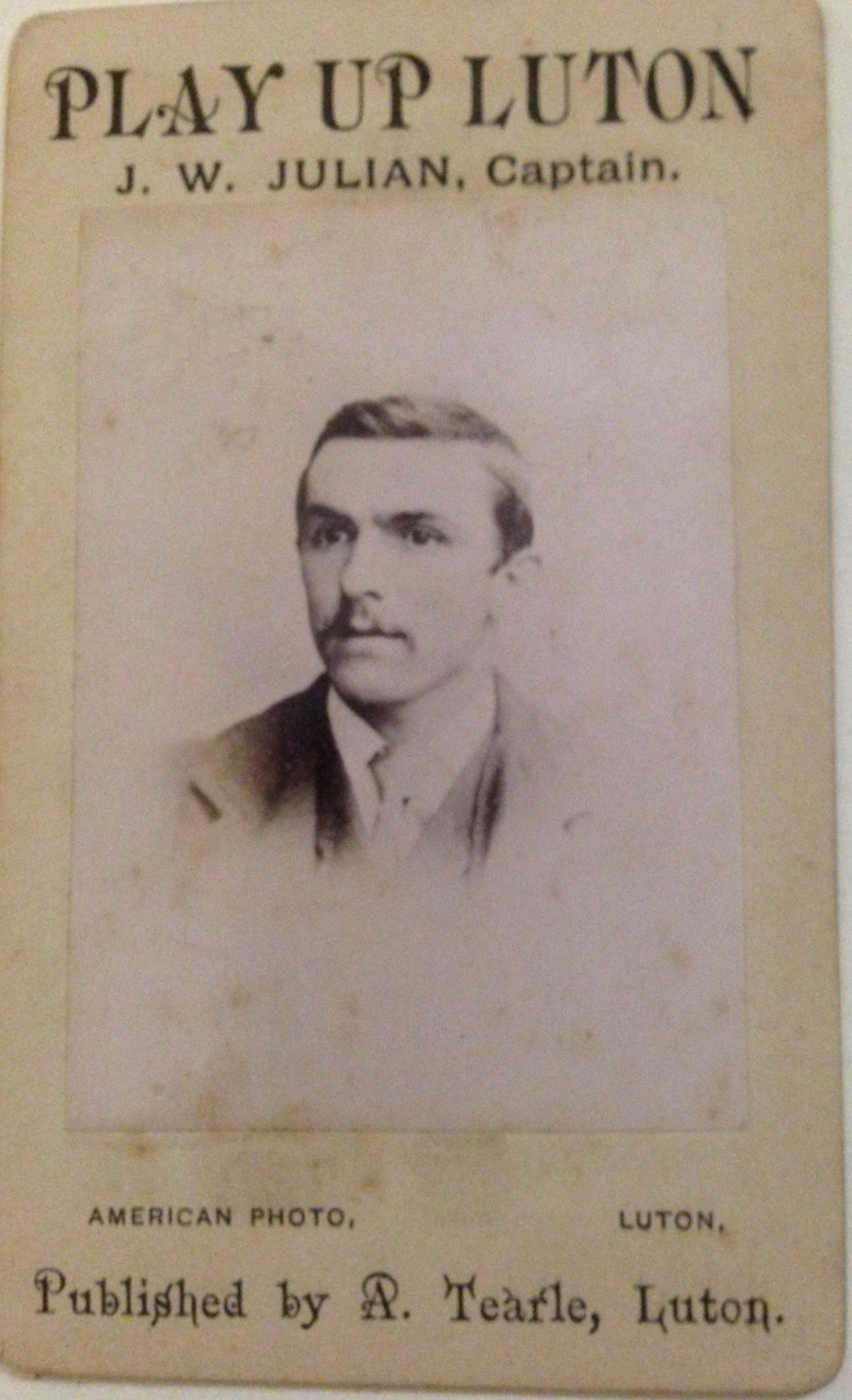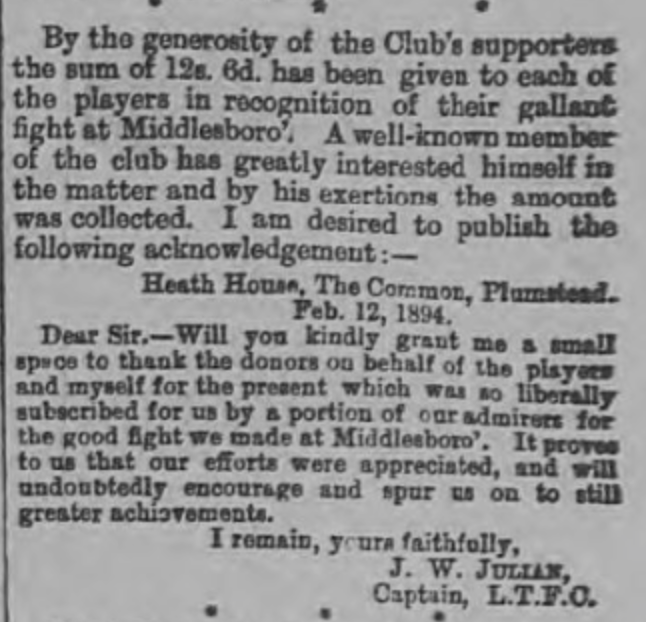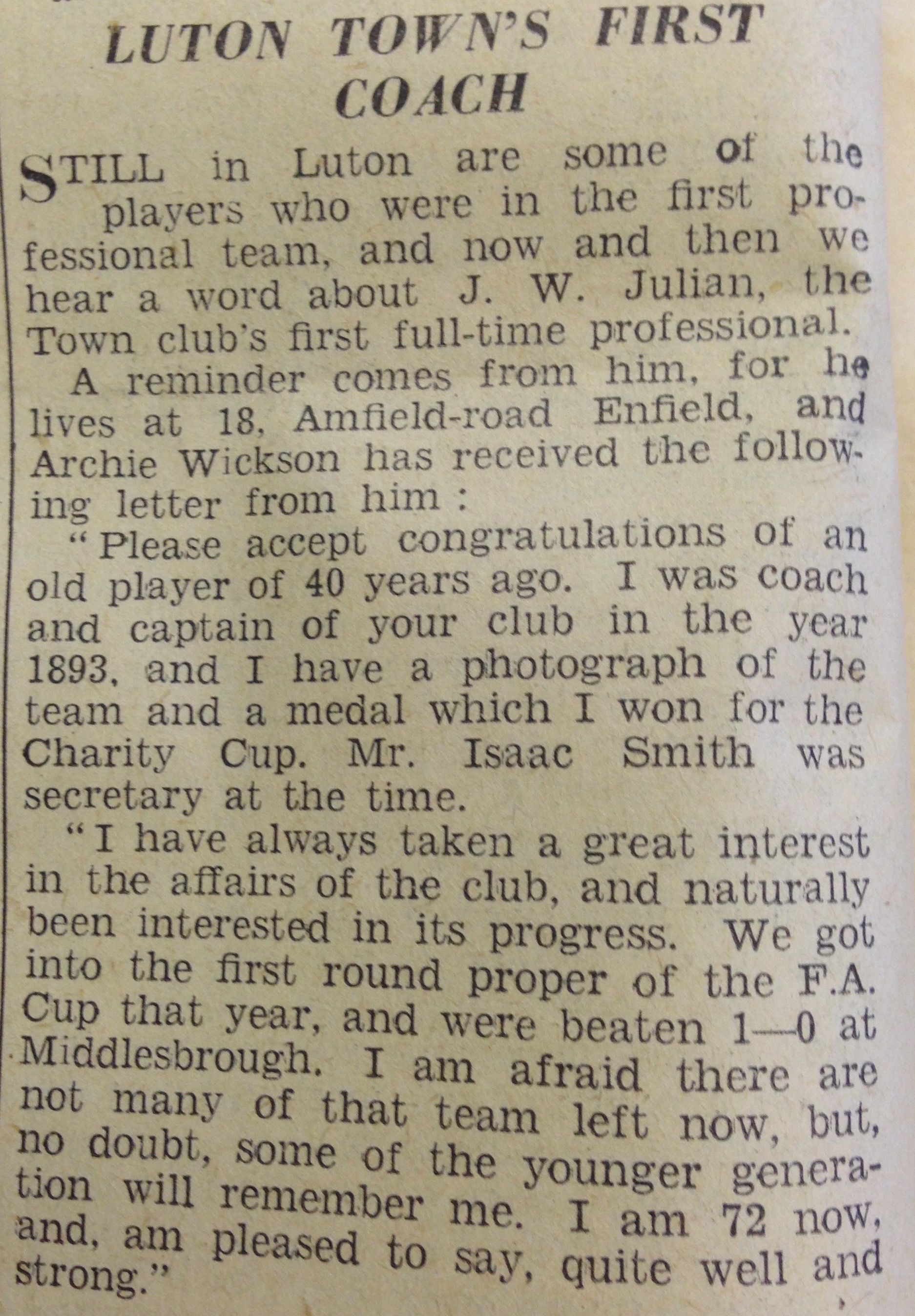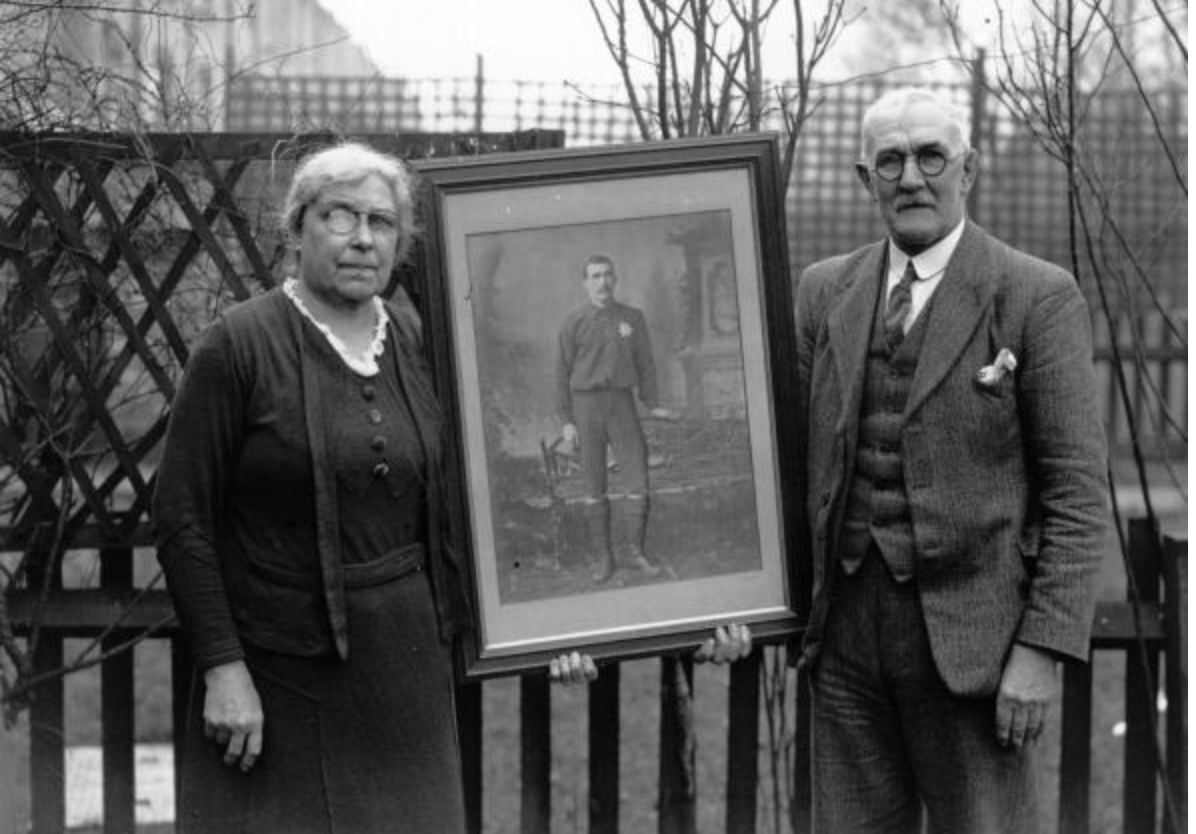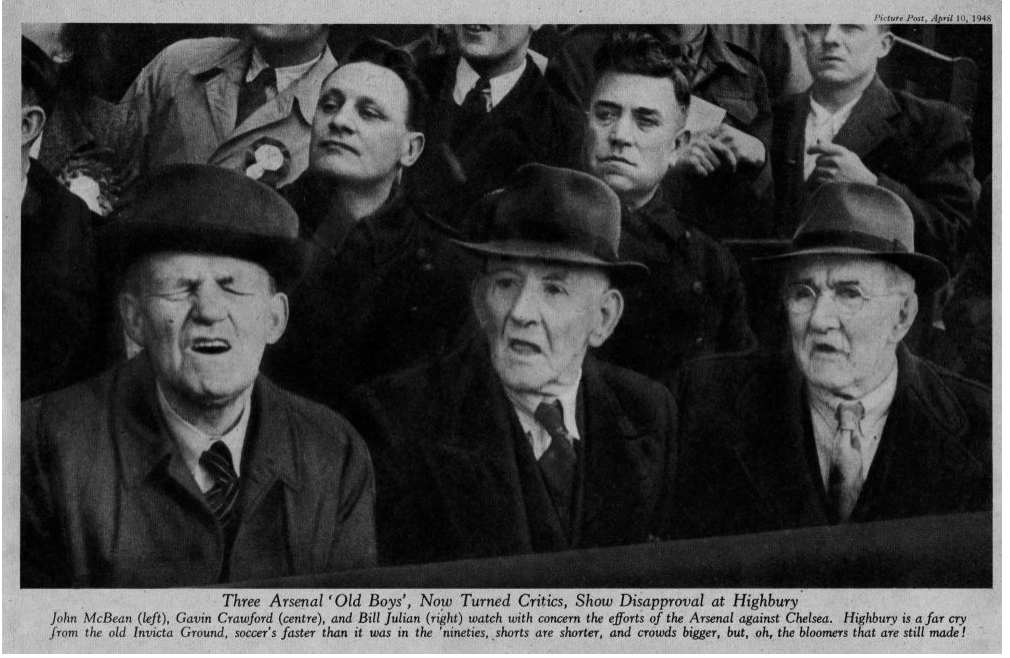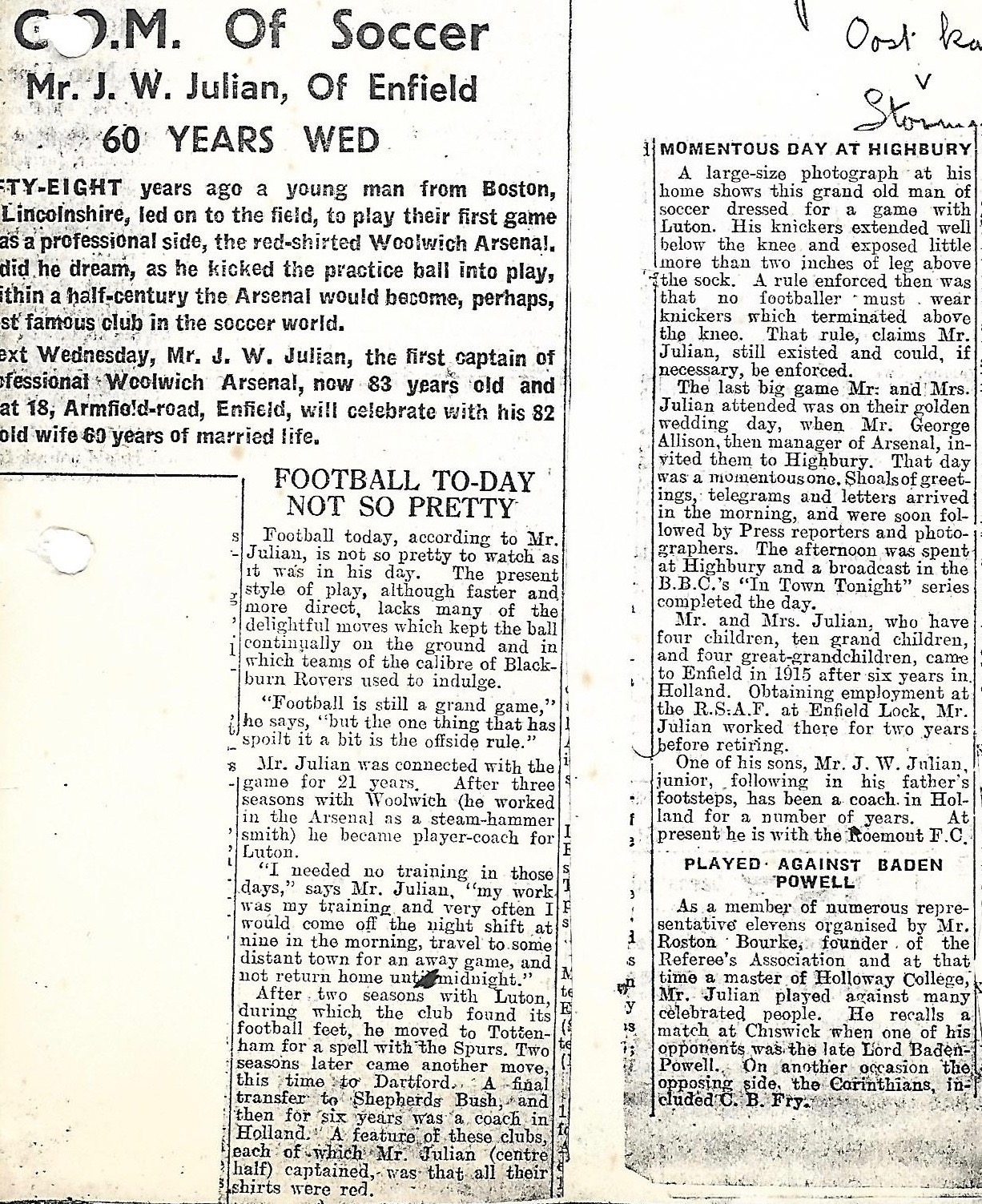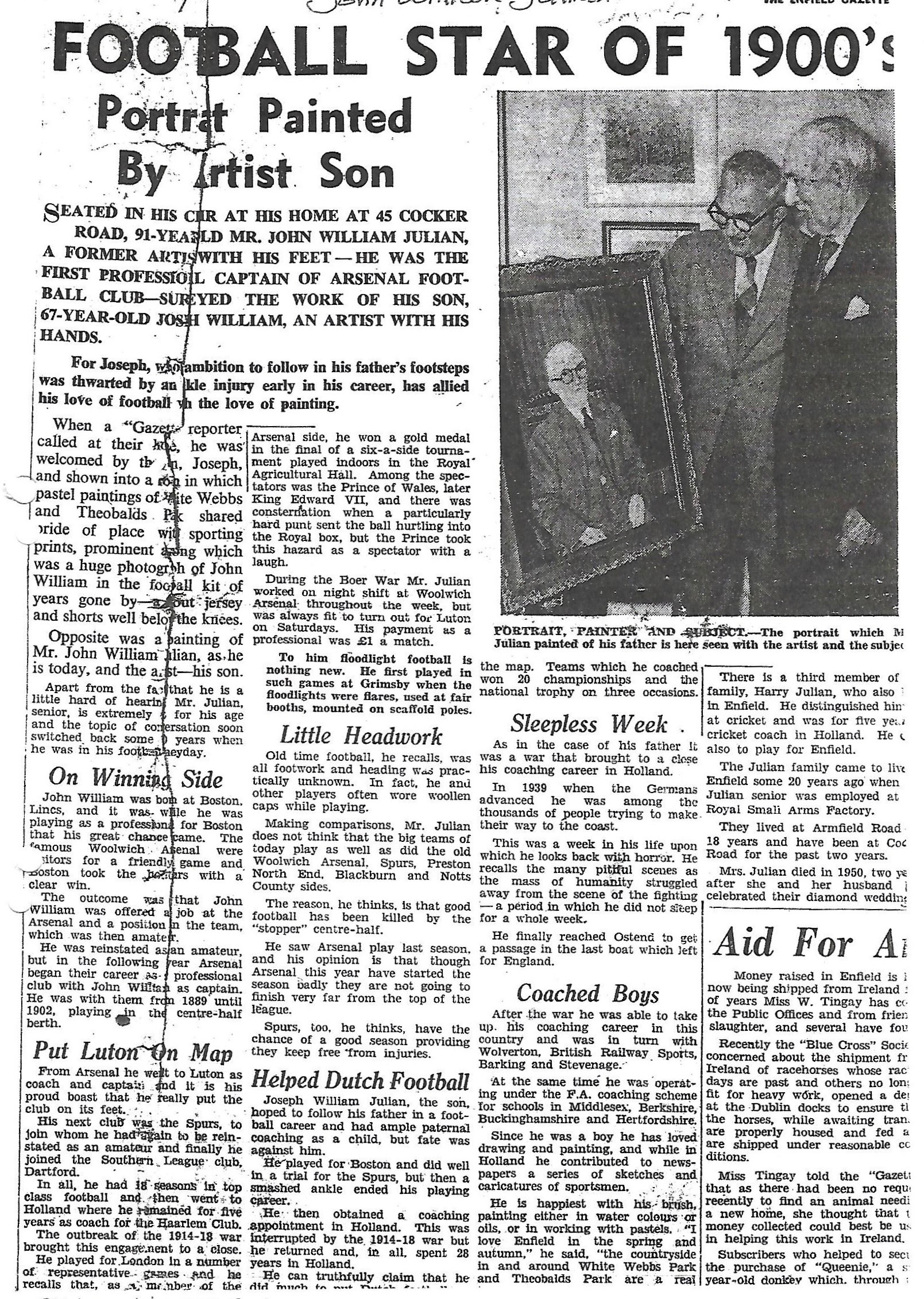John Eckford
John played 38 times scoring 4 goals for the club.
***********************************************************************
Walter Fairgrieve
Walter scored 6 goals in 19 appearances for the Straw Plaiters.
Born in Edinburgh on the 30th August 1874.
He was educated at Duke of Yorks’ Royal Military School; Royal Hibernian Military School; Queen Victoria School and Industrial School.
Played for Dairy Primrose; Glasgow Perthshire; Everton trial; Southampton 5/1898; LUTON 6/1899; Hibernian 1/1900; Partick Thistle 7/1900; Hearts 11/1900; Dunfermline 9/1901.
A Scottish Junior International and he also represented Glasgow.
A Wood Turner by trade who got married on the 11th August 1899 and fathered 4 children.
A career hampered by his drinking and general misconduct that earned him suspensions. This attitude carried over into his 252 days of military service. He was a Private who enlisted in the 15th Battalion Royal Scots on 24 September 1914 with a home address of 26 Caledonian Place, Edinburgh.
On 23rd March 1915 he was given 7 days field punishment (to include loss of pay) for being absent from the Commanding Officers’ parade and for not complying with an order given by a sergeant.
On 27th April 1915 he was confined to barracks (with loss of pay) for speaking to a C.S.M in an inappropriate manner and for then breaking out of barracks.
On 2nd June 1915 he was remanded to the Commanding Officer on a charge of causing a disturbance in the barracks at Troon. The charge was dismissed. While in the orderly room he was in a very excited state and complained of feeling ill. At 9.45am in the Sick Bay the Medical Officer found him to be suffering from a spasm of angina pectoris. The attack passed and he was left in a more comfortable state at 11.15am. He subsequently died at 12 noon.
The Medical Officer said that the private had latent heart trouble which could crop up at any moment which would normally be exceedingly hard to detect.
********************************************************************
Charles Ford
Charles made 45 appearances scoring 2 goals.
*************************************************************************
William Gracey Ford
Bill played 40 games for the Straw Plaiters scoring 9 goals.
***************************************************************************
John Butler Furlong
John Butler Furlong (son of George Furlong, committee member in 1885) was born in Luton in 1868. He was baptised in Cosheston, Pembrokeshire on 20th October 1872. In 1877 he was at boarding school in Upton, Slough.
J.B played football for St. John’s College, Luton Albany, Luton Wanderers and Luton Town. He was secretary of Luton Albany for the 1886/87 season. He appears to have played for Luton Town reserves for some time and made his debut in the first team in February 1888 when he scored the second goal in a three one win over Bedford. At the 1888 Annual General Meeting he was elected onto the committee of Luton Town F.C. We catch him appearing in a few matches but John Butler and his father George Furlong disappear from view in Luton in 1889.
In April 1890 J.B. gained employment at the Midland Locomotive, carriage and wagon department in Derby. He left in May 1890 with notice, the record book adding “Irregular Conduct.”
Andy Furlong kindly provided me with the following –
“John Butler Furlong held a record for ‘high diving’ and went by the pseudonym ‘Professor Vivian’. It is not clear why he adopted that name. There were reports in various papers at the time. He was a keen swimmer, so he was definitely a sporty guy. My aunt said he used to jump off bridges into water with a lit cigarette in his mouth and resurface with it still lit. I think he was quite the character.”
Thursday July 30 1891 – Birmingham Daily Post -“…made by a man to beat Burns’s record for diving from the bridge. The man was Professor Vivian, otherwise known as John B. Furlong. He hails from Luton and has…”
A John Butler Furlong appeared at Hanley Quarter sessions of the peace on 21st April 1892 charged with “obtaining goods with false pretences” for which he was bound over. The person used a number of aliases so whether it really was J.B. Furlong we do not know for sure.
The above clip is from the Evening Express 22nd October 1893.
The above clip is from the South Wales Daily Post 1893
J.B. married Kate in 1892 and they moved to Bristol where he became a schoolmaster, following in his father’s footsteps.
He died in Bristol in 1950 aged 82.
Newspaper clippings courtesy of Andy Furlong.
*******************************************************************************
Hugh Galbraith
From the Luton News 24th November 1892.
“Luton’s new centre forward has already established himself in the favour of local footballers, although he has only taken part in two matches under Luton colours. Galbraith, who is a splendidly built fellow, first opened his eyes to the light of this world on the 2nd December 1868, in Govan near Glasgow, and is therefore twenty-four years of age. He began playing football when he had reached the mature age of twelve, and so well did he like the game and so good were his performances, that his subsequent progress was very rapid. He joined the East End and afterwards Our Boys of Dundee, playing right half-back for the latter. Later on he took part in several important matches, playing against Kilmarnock, and for Forfarshire against Ayrshire. Galbraith came to England a few years ago, his first engagement being with Bootle. He was two seasons and a half at that place, and during that time he played against Dunbartonshire for Liverpool and District, and against Renfrewshire and Birmingham and District. His position on the field was then on the inside right. He afterwards yielded to the blandishments of the committee of Middlesbrough Ironopolis and played for them for a season and a half. The first year he was with them the “Nops” won the Northern League Championship, and Galbraith took part against such clubs as Sunderland Albion, Stockton, Sheffield United, etc. In November of last year our worthy Scot appeared as centre forward in the Barnsley team, a position which he occupied till the end of the season. His first match in his new capacity was against the Blackburn Rovers, who were beaten by three to nil, and he afterwards played against most of the League teams. At the beginning of this season Galbraith played for Burnley against Aston Villa, Sheffield Wednesday, and Sheffield United, and then a bit of unpleasantness with the committee of management caused him to sever his connection with Burnley. The fact of it was, the committee wanted him to make way for a new importation, and Galbraith rather than go in the Reserves, accepted Luton’s offer and came south. The Lutonians, however, only just managed to secure him, as within a very short time of his capture he received another and a better offer from the neighbourhood of Liverpool. It was very unfortunate for Luton that he had to be left out of the cup-tie on Saturday as his presence in the team would undoubtedly have been the means of turning the scale in favour of the Lutonians” [this refers to him being cup-tied against Polytechnic, who won 4-2].
Hugh Galbraith was offered 30/- a week by the club to entice him South. (he was the first player the club offered close season wages of £1 per week in order to retain his services). He and J.W. Julian were the first professional imports to the Straw Plaiters. Both coached the players who, in 1892, were mainly Lutonians. Hugh was closely marked right from the start. In his first game three Millwall players went to him every time he received the ball.
James Bennett later recalled that;
“When he got within 25 yards of goal the crowd with one voice would shout “Shoot Gally”. And he could shoot, too, and was not afraid to do so.” Bennett continued to say that while only of medium build “but with great speed, he could dance by the best of halves and leave them standing.” He adds that “Galbraith had a peculiar way of running with his elbows stuck out, which made it very awkward for his opponents to charge him off the ball.”
In his first season, 1892/93, he scored 30 goals in 23 games including two against Derby County. The following season the club played against higher ranking opposition and Hugh continued to receive very close attention and sustained many injuries. However, it has to be said that he dished out rough play and received it in return. He still managed to score 28 goals in 37 games in 1893/94 and helped the club win the Luton Charity Cup.
After the last game of the 1892/93 season, the club held a tea and smoking concert for the players, opposition,committee and well chosen guests. When it was time for entertainment Hugh took his turn and “rendered a jodelling (sic) song in first-rate style, and was compelled to substitute another piece in deference to to the enthusiastic applause of the audience.” He also acted as referee on occasions in friendlies and appears to have helped J.W. Julian coaching the players and did this unpaid.
On entering the Southern League in 1894, Hugh Galbraith ended all doubts about his title as the best centre forward in the South. He scored 12 goals in 14 League appearances and 4 goals in 5 F.A. Cup appearances. The following season he scored 16 goals in 15 League appearances and the clubs only goal in the shock F.A. Cup defeat to Tottenham Hotspur. He won three Luton Charity Cup winners medals in 1894, 1896 and 1897 and one Kettering Charity Cup winners medal in 1897.
Having left the Southern League, the 1896/97 season saw the Straw Plaiters play only in the United League where Hugh scored 6 goals in 10 matches. They did of course, also play friendlies, and F.A. Cup and the Luton and Kettering Charity Cup ties. Hugh scored a total of 28 goals in 41 games. Most of his goals (including three hat-tricks) were scored in the first half of the season when he played at centre forward. The club had a magnificent forward line at this time and he was moved to the wing for the majority of the second half of the season. The club won the Luton and Kettering Charity Cups and just missed out on a treble by finishing second in the United League.
Hugh had his benefit match against Millwall in the 1896/97 season when he scored twice in a three nil win. Note the advert by Bert Sanders, the ex Luton player on the match card and that the Plume of Feathers was “the Noted Football House.”
Hugh’s thank you letter to the people of Luton appeared in the Luton Times of the 18th December 1896 (above).
It was not all hard graft, injuries and mud as shown by the clip, above, from the Luton Times of 26th February 1897.
At the end of the season Hugh was hospitalised with rheumatism. It is interesting to note that the Club minute book in 1893 records that Hugh had asked the club about the “medical clause” in his contract. We are not told exactly what this was about but the club refused to alter the clause. He was confined to the Bute Hospital for many months. At the end of October 1897 he came back from a week at the salt baths at Droitwich. The Luton Times correspondent called on him and said he looked very ill but Hugh reported that the rheumatism had gone but his legs were as weak as matches. He could not wait to play “futba” again.
Hugh missed the whole of the 1897/98 season. He made his comeback in a friendly on the 26th September 1898 at home to Gravesend. He did not score as he was still rusty after his lengthy “holiday.” The Luton Times noted that he “had not yet forgotten how to play “futba.” He played three first team games in the Second Division and two in the United League without scoring. He got one goal in three F.A. Cup games. He played in many reserve and friendlies that season but retired at the end of the season. His last reported game was on the 4th March 1899 in a 4 1 defeat at Burslem Port Vale.
Hugh’s fame extended far and wide and the Dundee Evening Telegraph published an interview, below, on 26th February 1898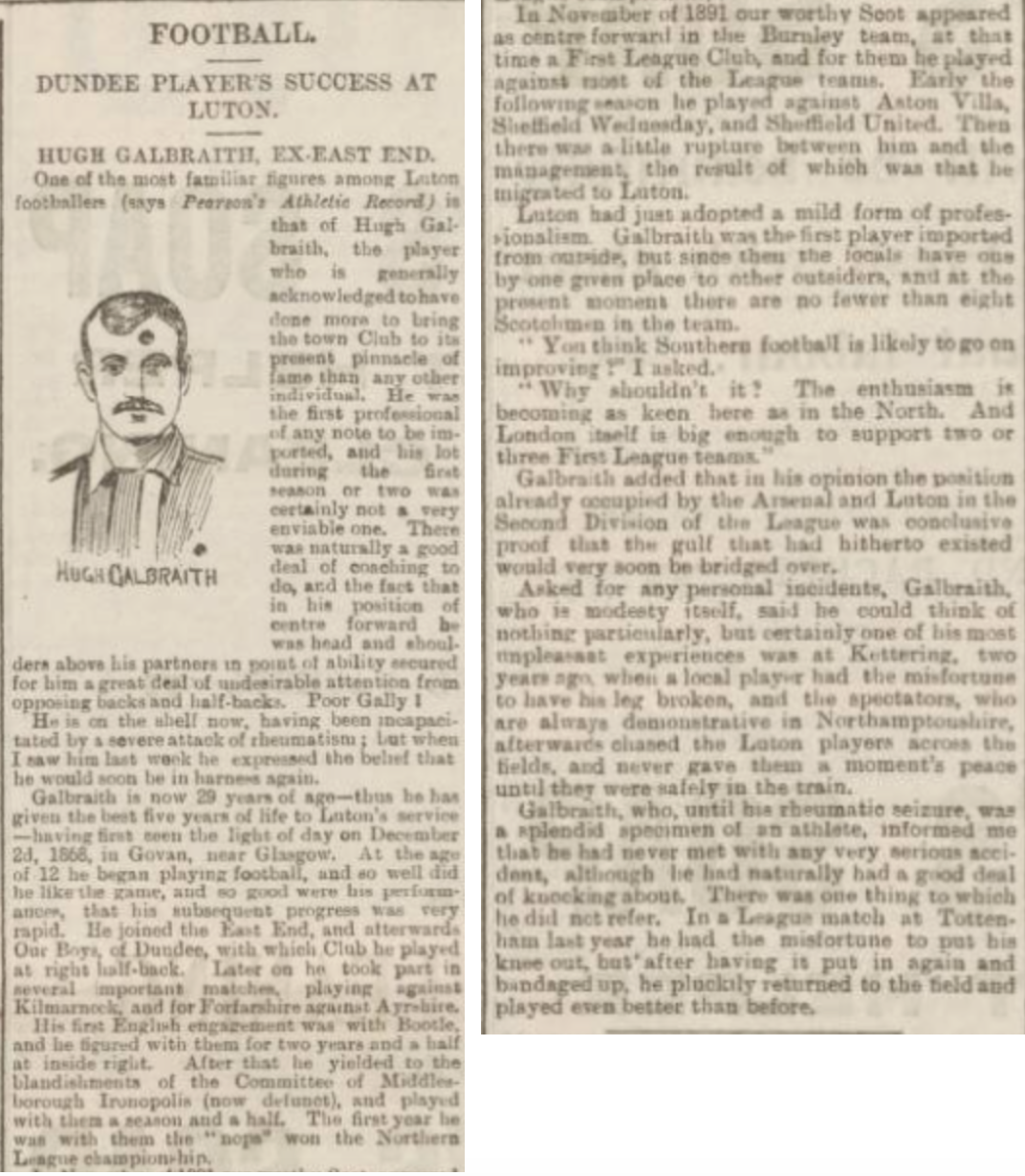
Hugh married a Luton girl as set out (above) by the Luton Times of 8th July 1898. Note the honeymoon in Eastbourne – one would hope that Gally had his photograph taken with his wife on this occasion.
After giving up football Hugh turned to the manufacture of hats. The advert, above, is from the Luton Times of the 13th April 1905
The clip, above, from the Luton News of August 1905, shows that Hugh was not forgotten and was used as the benchmark for assessing a forward.
If further proof were required of the great affection in which Gally was held by the Luton public, the appeal, left, appeared in the Luton Times of 20th November 1908
The clip, above, from the Annual General Meeting in July 1909 reveals the amount raised.
The 1911 census reveals Hugh live at 16 Mill Street with wife, son Alfred aged 11 and Madge aged 9. A third child, Harold, died in early 1909.
Hugh death was reported widely and the clip, below, is from the Yorkshire Post of 3rd March 1930.
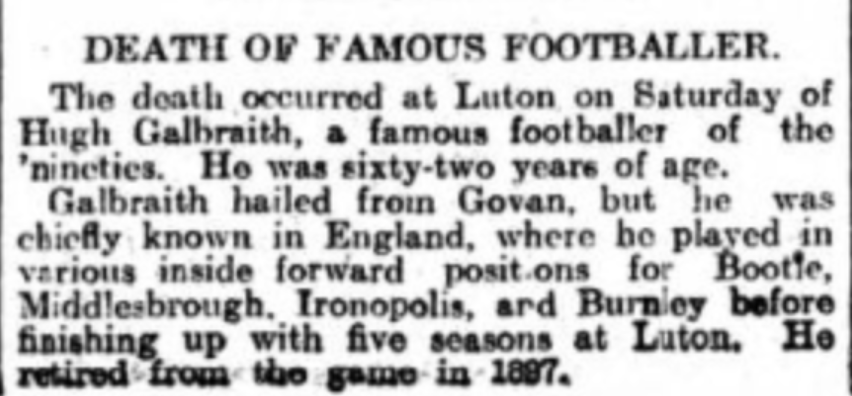
Hugh Galbraith is one of the greats of the club yet, like many of this era, has not received the applause he deserves. His goal scoring record ranks with any in the clubs’ history. He is the first of many truly great forwards the club has had since 1885.
*********************************************************************
James Herbert Gill
Born in early 1863 in March, Cambridgeshire and baptised on the 22nd February 1863.
Started as a pupil at St. George’s School in Brampton, Huntingdonshire in the Summer of 1878. All quotes are from the St. George’s School newsletter.
In 1882 he began to study at London University. The following year James played in a St. George’s School football match Past v Present in the “past” team.
He gained an Intermediate B.A. at London 1st Class in 1884.
1885 saw James played for Norfolk County F.C. v Old Westminsters on December 5th. He played cricket for St. George’s School and tennis and donated subscriptions and prizes to the Sports Committee. Joined the school band as a violinist. Continued to study at London University.
Was in the School football team and his profile describes him as an;
“Excellent half-back, sure and strong kick, with good staying powers, always in the right place.”
The team,
“Uniforms were Pink and white shirt faced with red, S. George’s cross on breast, red skull cap with white tassel, and S. George’s cross in front.”
The following year James continued to play football, cricket and was time keeper for the Athletics. In 1887 he left to teach in Kimbolton.
James returned to St. George’s School in 1890 as a new master “1st B.A. London (O.G.) is taking work again this term.” Played football, Cricket, Quoits, was involved in the school entertainment.
Played full back for Lynn v Norwich Thorpe in the final of the Norfolk Cup which they won 3 1.
Made his debut for Luton Town on the 11th October 1890 in the home defeat to Great Marlow. His appearances in the first team appear to have been very few and his last game was on the 29th November 1890 against Old St. Mark’s on the Dallow Lane ground.
He continued to played football and in 1891 he played for Lynn against Yarmouth in the Norfolk County semi-final. The St. George’s School magazine mentions that he “holds a temporary mastership at Kettering.”
In 1911 he was a school master in Kettering where he lived with his mother and sister. He died in Kettering in 1912.
Thanks to Sue Mitchell at St. George’s School, Harpenden for her very generous help.
*************************************************************************
George Hewitt
George played 27 times and scored 10 goals.
*****************************************************************************
Herbert Frederick Holdstock
Herbert Frederick Holdstock was born in St. Albans in 1879 where his father worked in the hat trade. However, his father was a Lutonian and as the hat trade in Hertfordshire declined, the family moved to the World Hat Headquarters that was Luton. In the 1891 Census the family is living at 11 Villa Road, Luton. Bert went to St. Matthews School.
Bert later went to the Higher Grade School in Luton, the same school as Bob Hawkes and they both represented Luton Schools as the clips below show. Another future Luton stalwart, Fred Hawkes also appeared along with some very familiar Luton names. The first clip is from the Luton Times of 19th April 1895 when Bert was at St. Matthews. The second clip is from The Luton News of the 6th March 1896.
Bert had a successful spell with Luton Star and was then signed on by the Straw Plaiters making his first team debut away to Sheffield Wednesday in November 1899. The entry below is from the Luton News Football Handbook of 1899/00.
Bert was highly thought of and his progress was followed by many clubs. The newspapers latched on to Bert and the clip below left was reproduced in many: this is from the Monmouthshire Beacon of 26th October 1900.
In 1901 he was a Straw Hat Blocker working at home, 92 Old Bedford Road, Luton, for his father’s business.
The Leighton Buzzard Observer of 27th August 1901 reveals Bert suffered an unfortunate injury;
“Never one of fortune’s favourites, has sustained a loss thus early, Holdstock, who took part in the first practice match, having met with an accident which will prevent him playing again. This talented young centre-half suffered last season from a weak knee, and on Sunday, as he was going upstairs, he slipped, and wrenched his knee so badly that he has finally decided not to attempt football again. He seemed likely to be one of the best footballers ever turned out of Luton, and his brilliant play last season attracted the attention of more than one first league club.”
The Luton Times of 10th January 1902 reveals his injury cost him a regular place in the first team;
“A quaint, Townsend-like figure in the half-back line is Holdstock, a young giant of 6ft., who was making a first appearance on behalf of the Luton first team this season. Time was when the tall and spidery half could hold his own with any of his contemporaries in the Southern League, but he hurt himself last year, and suddenly disappeared from the more important matches. If there is a more slender man playing football this year, I should like to hear about him.”
Bert’s injury meant he only made 42 first teams appearances for the Straw Plaiters scoring 2 goals. However, Notts Forest took a punt on him in the Summer of 1904. The Edinburgh Evening News of the 2nd June 1904 gave a list of the reds new players including “Herbert Holdstock, a Luton born half-back, who stands 6ft and weighs 12st 4lb.” It appears that the intention at the start of the season was for Bert to slot into the first team. However, he played most of the season in the reserves.
He was chosen to play in the first team for the game on the 8th April 1905. The Nottingham Evening Post previewed the game against Newcastle United at St. James’ Park;
“Timmins and Morris will again be absentees, and the selection of Holdstock to take the left half position will come as a surprise, the lengthy Lutonian not having been previously called upon in First League football.”
The reds were beaten 5 1. Bert is only mentioned twice in the report, both times mentioning his good play. It was not enough however, as that was his only first team game. The newspaper described his form in their end of season review as “disappointing.” Bert returned home.
The Luton News of 25th May 1905 latched onto the fact that Bert was back in Luton and said “Holdstock always was a good man, and unless he has deteriorated during his season with Notts Forest, the directors may go further and fare worse.” The club minute book shows that the directors thought long and hard about signing Bert on for the 1905/06 season. In the end they decided against and he never played for the Straw Plaiters again. Bert also managed to find time to serve on the committee of the Bedfordshire Football Association and was one of their officers at their AGM in June 1905. He did play football for local teams such as Luton Melrose but he decided to concentrate on cricket.
 His injuries did not seem to affect his cricket and Bert played for the leading cricket club in the town, Luton Liberal Club and scored 178, including 28 4’s on 31st July 1905 against a Bedford team. His form with the bat had attracted the county team and his first cricket game for Bedfordshire came in August 1901. He struggled at first to make an impression in the county side but the clip left from the Luton News of the 16th August 1906 shows he turned it round.
His injuries did not seem to affect his cricket and Bert played for the leading cricket club in the town, Luton Liberal Club and scored 178, including 28 4’s on 31st July 1905 against a Bedford team. His form with the bat had attracted the county team and his first cricket game for Bedfordshire came in August 1901. He struggled at first to make an impression in the county side but the clip left from the Luton News of the 16th August 1906 shows he turned it round.
The Luton Town Cricket Club was formed for the 1906 season and Bert was appointed club groundsman for the Wardown Park cricket ground. I have taken a summary of Bert’s career directly from the “History of Luton Cricket Club 1905-1980.”
“Bert’s association with the Town cricket club lasted until 1928 when he left the club. In 19 seasons he scored 13,456 runs at an average of about 45 and he took nearly 1,100 wickets at an average of just under 12 runs per wicket. This last figure is all the more remarkable when it is remembered that in his first 2 seasons with the Club he took only 3 wickets.
In 1913 he did the double, a rare event in Club cricket, when he scored 1296 runs and and took 102 wickets. He also passed the 1,000 mark in 1910 and 1911, a season in which he scored 6 centuries in his total of 1,349. When considering these figures it must be remembered that he only averaged 17 or 18 matches a season although in 1913 he played 30 matches.
In 1926, playing against L. & N.E. Railway he took all 10 wickets for 31 and made 85. In all he headed the batting averages 12 times and the bowling 13 times.
After the Second World War he returned to Wardown as groundsman for a short time before retiring.”
The above photo shows the 1908 Luton Town Cricket club team.
In 1910 the cricket game against Wolverton was set aside as a benefit game for Bert and the sum of £10 was raised, the highest amount raised for such a game. The 1911 Annual General meeting reveals that a payment of £42 was made to Bert for his duties as the professional at the club. At this time the census reveals that he lived at 31 Reginald Street with his wife Emily and daughters Doris and Madge. His mother and father lived with them. Bert was still a blocker but also a machinist.
He missed much of the 1921 season due to injury but returned as the Luton Town club professional for 1922.
The 1928 Luton Town Cricket team above. Back row, G. Hyde, H Pedrick, A. Fryer, H. Knight, H. Holdstock, W. Johnson, A. Worboys and G. Inwood. Front row, S. Sworder, F. Watkins, A.J. Mander (captain), H. Davey, William “Tip” Brown, G. Herringshaw, W. Rudd.
In the Summer of 1928 Bert was appointed as trainer to Luton Town Football Club’s reserve team playing in the London Combination. It was also in 1928 that Bert resigned as Groundsman in order to take up a new post with the London Brick Company at Wootton where he would supervise the laying out of a large sports ground and also act as professional to the cricket section. The captain said that Holdstock has served the club well for many years and they all wished him the best of luck in a new and better job.
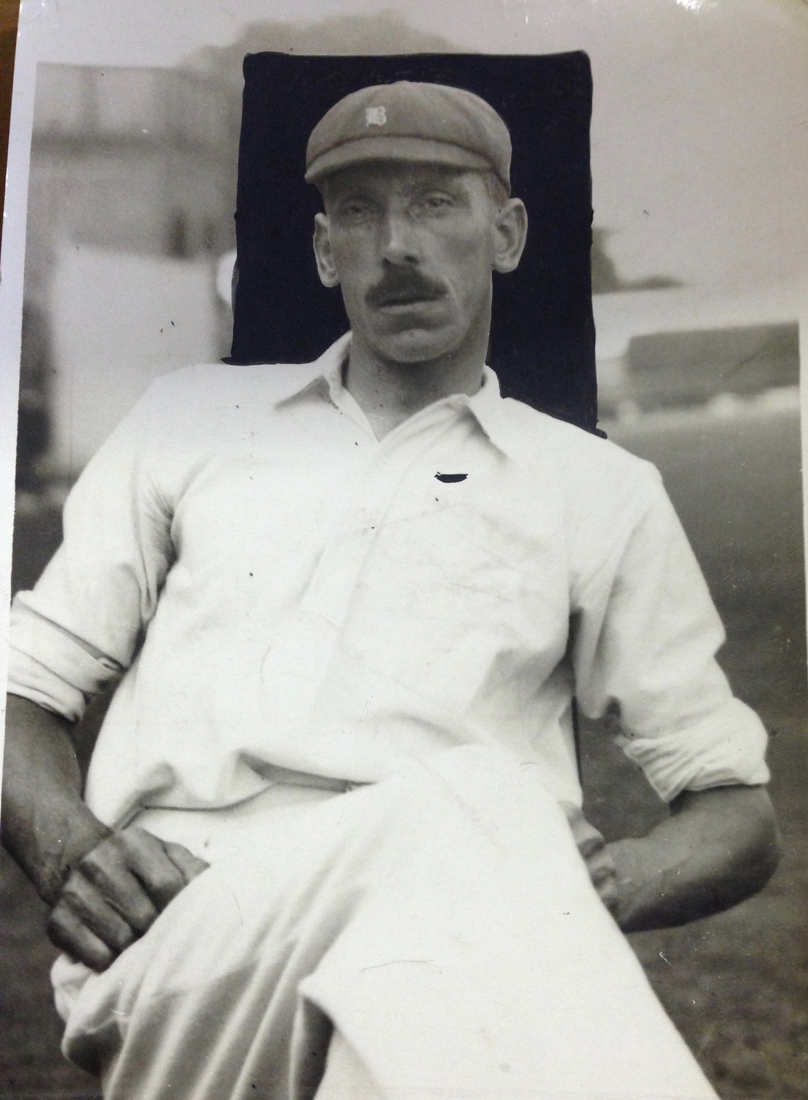 His record with the Luton Town Cricket Club was as follows;
His record with the Luton Town Cricket Club was as follows;
Total runs – 13,456
Highest Score – 153 in 1908
1000 runs in a season 3 times 1349 in 1911, 1296 in 1913 and 1157 in 1910.
20 centuries between 1906 and 1928
6 centuries in one season – 1911
1000 runs and 100 wickets in a season – 1296 runs and 102 wickets in 1913
10 wickets for 31 in one innings in1926.
Best season’s bowling average – 59 wickets for 504 runs at an average of 8.5 in 1919.
Bert’s career with the county side was also a long one as revealed by the Bedfordshire Times of the 9th May 1930, above.
And the Bedfordshire Times of the 7th August 1931, below.
 Bert continued to play for Stewartby during the 1930’s. A presentation was made to him in 1946 as reported in the 28th June edition of the Bedfordshire Times, left.
Bert continued to play for Stewartby during the 1930’s. A presentation was made to him in 1946 as reported in the 28th June edition of the Bedfordshire Times, left.
Bert was made a life member of the Bedfordshire County Cricket Club in December 1949 and an honorary umpire at the same time. He tended the Wardown Park cricket pitch and received the following accolade as reported in the Luton News of 1st June 1950.
Herbert Holdstock died in April 1966 in Bedford.
I am indebted to Peter Webley for Bert’s cricket records which are taken from “A History of Luton Town Cricket Club 1905-1980.”
******************************************************************************
Alfred Ernest “Jack” Hoy
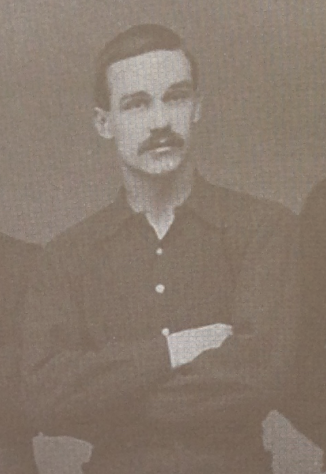 Born in Luton on the 26th May 1869. In the 1871 census Jack lived with his parents Charles (a publican) and Ellen at the Folly, Luton Road, Wheathampstead. Jack was baptised at Christ Church, Upper George Street on the 28th June 1876. By the 1881 census the family were living at 174 Wellington Street Luton. Jack was at school, his father was now a warehouseman.
Born in Luton on the 26th May 1869. In the 1871 census Jack lived with his parents Charles (a publican) and Ellen at the Folly, Luton Road, Wheathampstead. Jack was baptised at Christ Church, Upper George Street on the 28th June 1876. By the 1881 census the family were living at 174 Wellington Street Luton. Jack was at school, his father was now a warehouseman.
By 1891 the family had their own hat business at 2 Russell street. Charles is described on the census as a Straw Hat manufacturer, Jack a Blocker and manager. His younger brother, Frank who also played for Luton Town, is described as an “assistant.”
From the Luton News 1892;
“ More familiarly known as Jack Hoy, commenced playing football around 1885-86 with a team called the Church Institute. In 1889 he made a few appearances for the Town and at the beginning of 1890-91 season played for Luton Montrose. He fought in the Montrose ranks against the Town Club in the Luton Cup competition, and he gave such a good account of himself that he was again invited to become one of the senior club’s team. He played against Wolverton in the Kettering Cup at Luton which resulted in a draw. When the clubs went to Wolverton for the replay, the match went into extra time, and after that half hour period Luton were beaten 2-1. He played in Luton’s first match of the 1891-92 season, but didn’t give a good account of himself, so the committee asked McFie of the London Caledonians to take over Hoy’s place. The committee found that they had jumped out of the frying pan into the fire, and Jack was asked to take up the position again. He did so and has continued to play regularly for the Town since. His place is at back, and it is generally conceded that no member of the team has show such consistently improving form as he. It takes a good man to get past Jack now, as he is a good tackler and first-rate kicker, a feature of his play being his remarkable sureness with his left foot.”
London Evening News of January 1892.
“Hoy was formerly in the Reserves. This is his second season in the first eleven. He has improved wonderfully of late, and often proves a great thorn in the side of the opposing attack.”
Jack was a consistent performer at back and rarely had a bad game. His partnership with Bert Sanders was a formidable one which gave great confidence to the rest of the team.
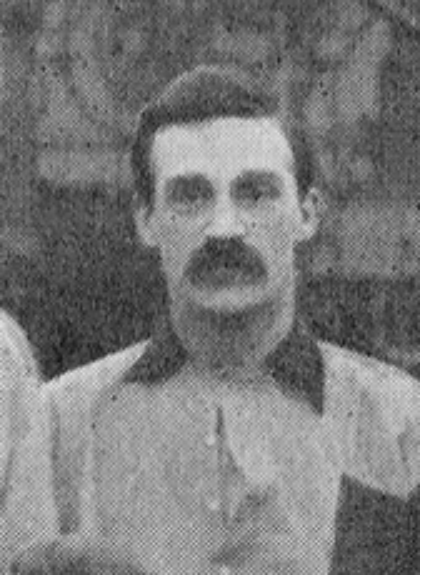 Many players were signed when the club entered the Southern League in 1894 and Jack was consigned to the reserves. He went to play for St. Albans (pictured left in his St. Albans pink and black shirt) in 1895. He stayed just one season playing 24 games scoring one goal.
Many players were signed when the club entered the Southern League in 1894 and Jack was consigned to the reserves. He went to play for St. Albans (pictured left in his St. Albans pink and black shirt) in 1895. He stayed just one season playing 24 games scoring one goal.
 Left, from the Leighton Buzzard Observer 29th September 1896
Left, from the Leighton Buzzard Observer 29th September 1896
He married Elizabeth Maria Puddephatt on the 24th September 1896. The 1901 census shows he and Elizabeth were living at 50 Buxton Road with their two sons Eric and Kenneth. Jack was a Straw Hat manufacturer at this time. By 1911 they had one further son Leslie and they lived at 33 Stanley Street.
Jack passed away in Luton in the Summer of 1944
*******************************************************************
Herbert Edward Hucklesby
Herbert, who played back or half-back, turned out for most of the High Town teams in the early 1880’s – Wanderers, St. Matthews, Luton Rovers, Park Rovers, Luton Town (late Wanderers) and then Luton Town. The only mention I can find for the latter is that he was a reserve for the Luton Town reserves against Oakshott in October 1885.
It has proved difficult to locate much information on Herbert but we are fortunate that he celebrated his Golden Wedding anniversary in 1936. The following clip is from the Luton News;
Herbert died at St. Mary’s Hospital Luton on the 25th May 1945.
***************************************************************************
Thomas Nelson Hughes
Thomas was a committee member from 1890 until just before his death in October 1893. He organised a collection for the club to purchase Brodies goal nets. His obituary as appeared in the Leighton Buzzard Observer of 10th October 1893 appears below. I will add to this entry as more information on Thomas is discovered.
**************************************************************************
James Allen Inglis
James played just 3 games for the Straw Plaiters.
*************************************************************************
Henry Jackson
The first set of clips are by kind permission of the University of Leicester and taken from “The Wyvern” of 6th December 1895.
Henry looks older in this next photograph.
The clips below are from the Luton News of the 26th August 1897 detailing Henry’s appointment as club secretary. I have left in some interesting news at the end of the second clip.
*************************************************************************
John William Julian
We are fortunate to have a profile of John William “Bill” Julian which was published in the Luton News of 8th September 1892.
“Footballers in different parts of the country have already entered upon their favourite winter pastime. On Saturday enthusiastic lovers of the game will be kicking their heels around the ropes on the Dunstable-road ground, anxious, oh, how intensely anxious! to get an idea of the manner in which the Luton team will shape up during the coming season. Naturally the greatest interest will be shown in the new centre half-back, who is a total stranger to the district, but of whom great things are expected. J.W. Julian – that is his name – comes to us from the Royal Arsenal, having transferred his services from one team of “reds” to another. Perhaps a few words as to his past history will not be out of place. To begin at the beginning, Mr. – he was only then Master – Julian was born at Boston in Lincolnshire, on July 10th 1867, and is consequently 25 years of age. He was a sturdy youth from his birth upwards, and took to football in a regular way when he was sixteen years of age, then joining a local club called the Excelsiors. His abilities as a player soon made him prominent, and he was spotted by the premier club of the town and induced to join their ranks. The following season saw him captain of the team, a position which he filled for two years, taking part in all cup ties and ordinary matches during that period. He was prevailed upon to come to London to join the Royal Arsenal after the latter had paid a visit to Boston and suffered defeat to the tune of five goals to two. He has been connected with the Royalists for three seasons, and he had the honour of captaining the team during the most successful part of the club’s career. While playing with them, previous to their taking to professionalism, the Arsenal won the London Cup, and Kent Charity Cup and London Charity Cups. Julian has played both or London and Kent County, and had gained six medals since being at Woolwich. He was also one of a team of six picked Royalists who competed for the shield of the National Physical Recreation Society is a six-a-side contest at the Agricultural Hall, and they won the trophy, beating London Caledonians in the final round by one goal to nil. Upon this occasion the had the honour – I suppose it must be called an honour – of playing before the Prince of Wales. Last season Julian played for the Arsenal in several of their first team engagements, but the greater part of the time saw him as captain of the Reserves, as he had to stand down to make room for the highly-paid Scotch importations, who in the opinion of man, failed to show up as well as the old amateur team had previously done. The performance of the Arsenal Reserves, however, was a very excellent one, as they lost but two matches during the whole of the season, and those two by a goal each only. Julian has not always been at centre-half. He has filled every position in the field, except that of goal-keeper, in the course of his career, but his favourite place is at half-back. He has played against most of the leading clubs of England. His height is 5ft. 9ins., and his weight is 11st 13lb., so that physically he could not have been better suited for a half-back had he been built to order. The papers speak very highly of Julian, the Star, which gave a portrait of him twelve months ago saying, “Of the Royalists’ many champions, J.W. Julian is not the least. His position is at half-back, where his strong tackling and judicious placing of the ball are invaluable to his side. Julian can playa good game at forward when required, and has had the honour of representing London. The following are a few brief extracts from the Woolwich papers:-
“J.W. Julian has, I should think, made and beaten all records as far as Plumstead football is concerned, for he has played and shown consistent form in every one of the first team’s engagements this season (1890).”
“Julian played his old game. Great credit is due to this grand half, for without taking care of oneself it would be impossible to come up to the scratch in such fine condition as Julian on every occasion shows.”
“All three of the halves did their work brilliantly. Julian has never played better than he did on Saturday. This is saying a great deal of a man who has always played a sound and consistent game.”
“I thought Julian was the best man on the field. The way he shadowed his opposing wing was a treat to witness.”
I might go on adding any amount of testimony to Julian’s ability, but the above will be sufficient to show that the Luton executives, in engaging him, cannot be accused of having brought a “pig in a poke.” His credentials are of the highest order, and though the place vacated by “good old Paul” is a difficult one to fill, there seems to be every reason to believe that Julian will prove fully equal to the task.”
Here is Bill, above, in the Boston Excelsior team of 1886/87, back row, extreme right.
Bill continued to live in Plumstead after his signing. The 1891 and 1901 census returns show his occupation as a Blacksmith. The Club gave him a substantial wage (the other players were paid 5/- a week) plus his train fare from Plumstead for the games. We are not given his exact wages but for the second season he was paid 15/- all year round (as opposed to a larger sum during the season and a lesser sum during the close season).
Bill was immediately made captain of the team and the committee put their trust in him to deal with tactical and disciplinary aspects straight away. The committee asked him to speak to the team in September 1892 as there was some jealousy within the team which was affecting performance. The committee also asked him on occasions to bring some players with him from Plumstead for a trial. Royal Arsenal had 20 professionals on their books and some would have had the same attitude as Bill and wanted first team football.
He proved to be an inspirational signing by the committee. His two years at Luton saw the club make the short but difficult road from the pack, to the third best team in the South of England (with the Royal, later Woolwich Arsenal way ahead at the top and Millwall slightly ahead of the Straw Plaiters). It was a remarkable rise and Bill should take his share of the credit. A tough no-nonsense half back he lead by example. In the 1893-94 F.A. Cup the Straw Plaiters met the Old Westminsters away. This was a formidable test and Bill saw the danger and marked the dangerous centre forward, Sandilands, out of the game. His no-nonsense clearances and tough tackling helped the club to a famous victory. It was this victory that made the football world stand up and take notice of Luton Town Football Club.
Bill led the team into the first round proper of the 1893/94 F.A. Cup where they faced Middlesbrough Ironopolis. A narrow 2 1 defeat did not tell the full story as the Straw Plaiters were thought by the neutrals to be the better team. The supporters were very proud and the Luton Times clip of 16th February 1894 (below) takes up the story.
A consistent all round player, Bill had an eye for a goal and was a good header of the ball – the latter being quite a rare attribute at this time. As captain he pushed his men forward as in the home game with Millwall in January 1894;
“The Luton men slackened off somewhat, and with inexcusable stupidity the visitors did not see their opportunity, and also allowed their pace to slow down. Then Julian told his men to “gird up their loins,”….”
The Straw Plaiters went on to record a famous victory over Millwall, the early favourites for the forthcoming Southern League title. Later in 1894 he led the club to their first trophy, the Luton Charity Cup. After a four one victory over Wolverton L. and N.W. he was presented with the trophy (see Library, Luton Charity Cup). The Luton Reporter takes up the story;
“Mr. Julian, who was enthusiastically cheered on carrying off the cup, was saluted with cries of “Speech.” In response, he said he was heartily pleased to receive that beautiful cup on behalf of the Luton Club. They had tasted the bitters—(laughter)—and now they had got the sweets of victory (applause). He was sure no one in Luton was more proud than he of the victory, and he was certain that all the other players were pleased. Their opponents appeared to him to accept their defeat in a very sportsmanlike and honourable manner (applause). The game was not what could be called a good game, but there was no doubt that it was a very fair game. He hoped the club would succeed in doing better things (loud applause).”
A dispute about out of season wages caused Bill to resign from the Straw Plaiters in May 1894. The committee appear to have valued forward players more than a half-back. The centre forward Hugh Galbraith was offered 30/- a week on signing in 1892 yet Bill was on half that. It was a poor decision by the committee as Millwall went on to win the first Southern League season by a narrow margin. Bill’s leadership, physical presence and discipline might have proved the difference. After leaving Luton Town, Bill signed for Tottenham Hotspur. In late 1894 he was approached by Nettie Honeyball who had placed an advert in the newspapers for 30 young ladies to join her British Ladies Football Club. Bill agreed to coach the ladies.
He played in Spurs very first F.A. Cup tie on 13th October 1894 when they beat West Herts 3-2 n the first qualifying round. He left a year later and finished his career at Dartford. He opened a sports shop in Plumstead but left for the Netherlands where he coached many teams including Feyenoord, MVV, HBS, Be Quick 1887, GVAV and Willem II twice.
The above clip is from the Luton News of 20th January 1938.
Bill and his wife, above, on their golden Wedding Anniversary, 3rd February 1938
Above, at an Arsenal game in 1948.
I am indebted to Jean Douglas-Wood for providing the following newspaper clips. The first is from 1938.
The next two clips are from 1948.
The final clip, below, is from 1957 just before Bill’s death.
Jean also produced the following history of Bill’s life which I have reporoduced without change.
“John William Julian b. Boston, Lincolnshire 1867 and d. Kettering, Northamptonshire 1957 at the age of 90.
The 1902 census records him as a blacksmith employed at the The Royal Arsenal and living at 11 Bebbington Road, Plumstead, London. But he was so much more than that. It is our family’s understanding that John William Julian and his sons Joseph William Julian and Harry Julian did a huge amount to put European football on the map and in that respect, we all feel as a family that their contributions have not been fully recognised.
Known as Bill, he was the son of William Julian and Ellen Mawer of Boston Lincs, one of 9 children. His father William was a Yorkshireman born in Beverley and his Julian ancestors have been traced back to the 1500’s in that county.
Bill joined Boston Town FC at the age of 18, apparently using local public houses as changing rooms near to where the match was held. He was at Boston Town from 1885 to 1889 playing professionally as captain. According to a newspaper article it was as the result of their defeating the then amateur Woolwich Arsenal in 1889 that the 22 year old Bill was ‘poached’ from The Poachers.
He was offered a job at The Arsenal as a steam hammer operative.
The year before he left for London, Bill had married Edith Emerson in July 1888 and their first son Joseph William Julian (also to be known later as Bill) was born in 1889 in Boston before they left. Bill Jnr was to later follow his father’s footsteps by playing for Boston Town, presumably staying with his grandparents while he did so. There is a picture of him in the line up of 1909 on the year that Boston won the Hospital Cup.
Bill and Edith went on to have 3 sons and a daughter in all.
Note. The photograph of the 3 old boys of Arsenal (John Mc Bean, Gavin Crawford and Bill Julian) at the Arsenal V. Chelsea match in 1948 at Highbury was part a set taken by Picture Post, only one of which was used ( Vol 39 No2 April 10th 1948)
Apparently during the Boer War, Bill worked 5 night shifts a week and stated that he was always fit enough to turn out for Luton on a Saturday. In one article it records that he was paid £1 a match, which doesn’t seem much these days, but undoubtedly was a great deal then, although nowhere near the gross amounts that today’s footballers are paid.
In the Enfield Gazette article of July 1948, recording his 60th wedding anniversary, he was described as having been ‘one of the best half backs in Southern England’ and goes onto say that ‘Under his leadership, the Arsenal won the Kent County, London and London Charity Cups’. One of his treasured possessions was his London Cup 1892 gold medal, which tragically, has been stolen some years ago from the family archive along with other significant memorabilia.
As well as playing football, he also managed to find time to win a medal at skating and once rode a penny farthing for 75 miles! Society doesn’t make many men like that anymore.
In another unidentified newspaper clipping, discussing his fitness levels, he said that
‘I needed no training in those days, my work was my training and very often I would come off a night shift at nine in the morning, travel to some distant town for an away game, not returning until midnight.’
In all, Bill had 18 seasons in top class football. He reminisced, in one newspaper article, about playing a six a side match, as a member of Arsenal, at the Royal Agricultural hall. According to The Enfield Gazette c1956 ‘Among the spectators was the Prince of Wales, later King Edward VII, and there was consternation when a particularly hard punt sent the ball hurtling into the royal box, but the price took this hazard as a spectator with a laugh.’
He also played against Baden-Powell at Chiswick, as ‘a member of numerous representative elevens’.
After retiring from football as a player, family anecdote has it that he opened and ran a sports shop in Plumstead but no-one can work out where it used to be or when it was open. However, it must have been along the walking route to the nearby stadium because family memory states that he had a wooden model of a footballer with articulated legs in the window of the shop. He would cause the manikin to kick a brand new football into the crowd of fans on match days, the person who caught it, keeping it.
In around 1906 family record has it that Bill was contacted by the then fledgling Dutch Football Association and was asked to help coach some Dutch teams.
So, Bill and his wife and children all re-located to Holland, which began a close relationship with the country that still persists today in some of his descendants.
The family stayed out in Holland until the outbreak of WW1, Bill during that time having coached Maastricht, VVV Venlo, PSV Eindhoven and HFC Haarlem ably assisted I believe by Bill Jnr in later years and perhaps son Harry was later associated with Maastricht FC. There are several rather faded old newspaper clippings from that time within the family archive.
He may have managed HBS Den Haag and Feyenoord Rotterdam from between 1921-22 after a brief return to Holland after the war, the family are not sure whether this was Bill Snr or Jnr.
On the Feyenoord team website, discussing the history of the club, the team was described as ‘an ambitious club but had to wait until 1921, when thanks to the services of an Englishman Bill Julian, they finally gained promotion to the top flight’
In 1938 Bill and Edith celebrated their 50th wedding anniversary. They were invited to a football match at Highbury, by the then manager George Allison. They had a busy day full of greetings, telegrams and a press report. Amongst the telegrams was one from JC Carnell of the BBC inviting them both to take part in the live broadcast of Radio’s ‘In Town Tonight’. It is unknown whether this recording still exists.
Bill is remembered in the family as a hard working and genial fellow. He died sadly in the very same year (1957) as his eldest son Bill Jnr. Both of them living in a small place in Kettering.”
Bill died in Enfield in 1957 aged 89.
Thanks to;
Jean Douglas-Wood
The Luton News
arsenalonetwofive.wordpress.com
Roger Wash
Getty Images



